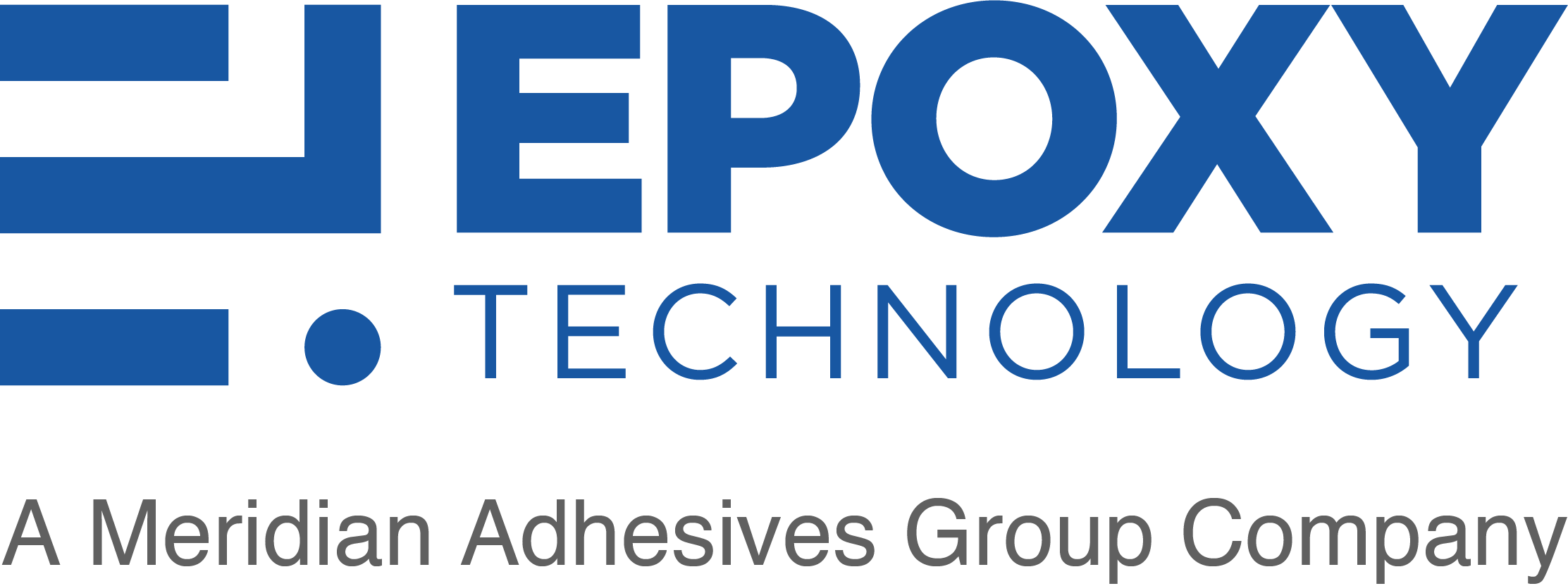EPO-TEK® High-Speed Data Transmission Devices
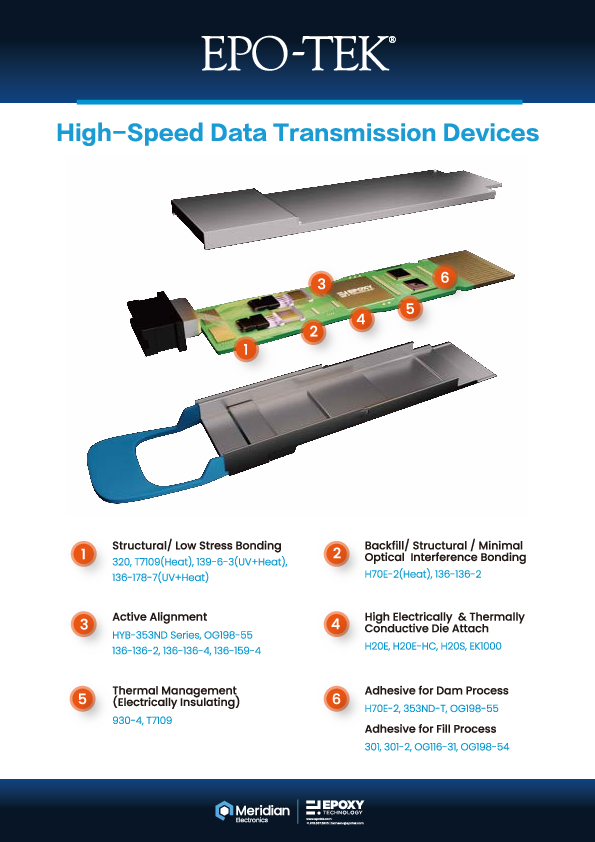
Discover EPO-TEK® specialty adhesives engineered for fiber optic assemblies and optoelectronic devices.
EPO-TEK® Low Outgassing Adhesives
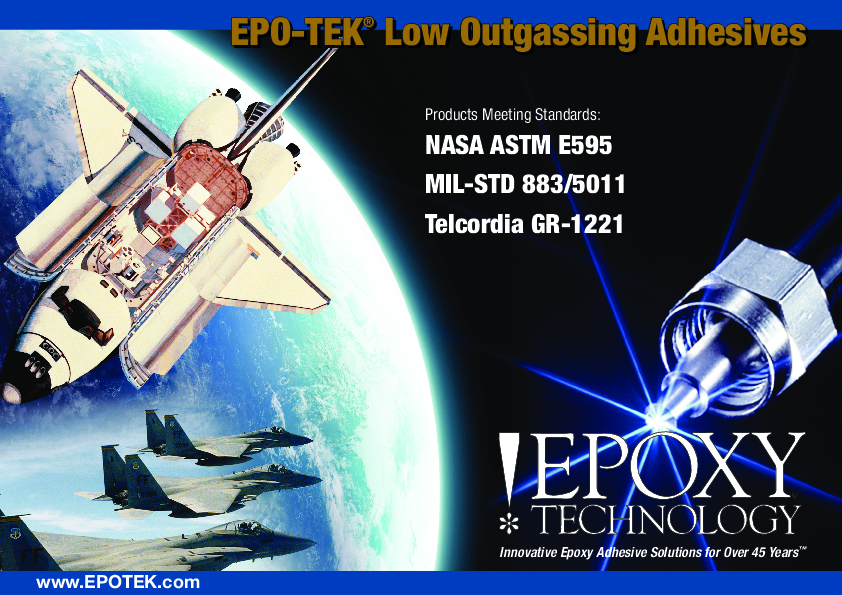
Epoxy Technology announces its newly updated Low Outgassing Adhesives brochure which includes several products that now meet the NASA ASTM E595, MIL-STD 883/5011 and Telcordia GR-1221 Standards. This brochure allows users to select the most appropriate EPO-TEK® material; meeting the most stringent requirements necessary in critical designs.
Cure Matters- Determining the Proper Cure Schedule
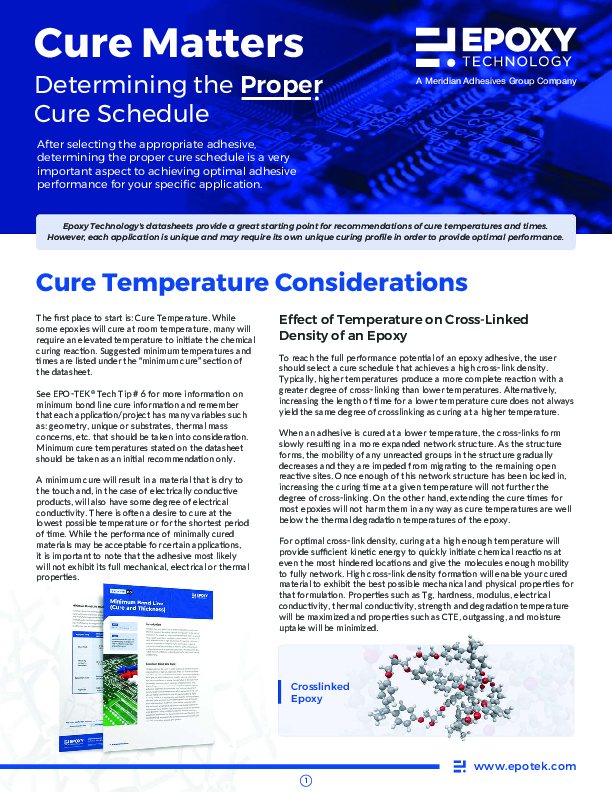
After selecting the appropriate adhesive, determining the proper cure schedule is a very important aspect to achieving optimal adhesive performance for your specific application.
Also available in: GermanIntroducing EPO-TEK®O205NC
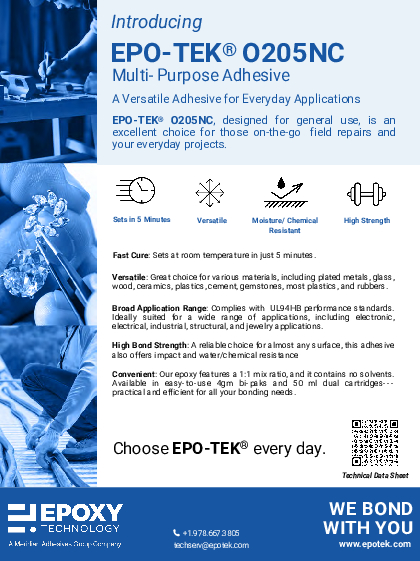
Epoxy Technology’s Latest Offering, EPO-TEK® O205NC, is designed for general use and is an excellent choice for those on-the-go field repairs and your everyday projects.
Custom Formulation Services 2018
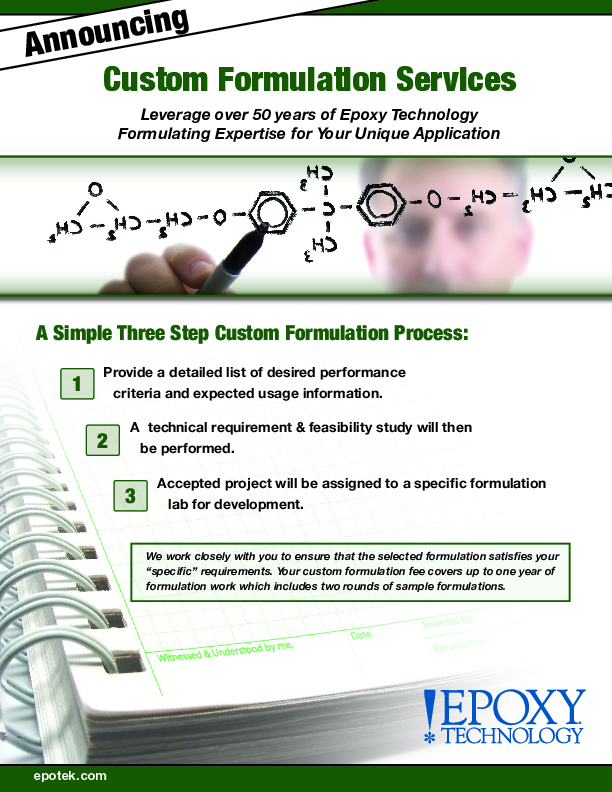
Epoxy Technology provides custom formulating services to our customers. Leveraging our over 50+ years of specialty adhesive formulating expertise for your unique application to ensure that we meet your specific formulation requirements.
EPO-TEK® Specialty UV Curing Adhesives
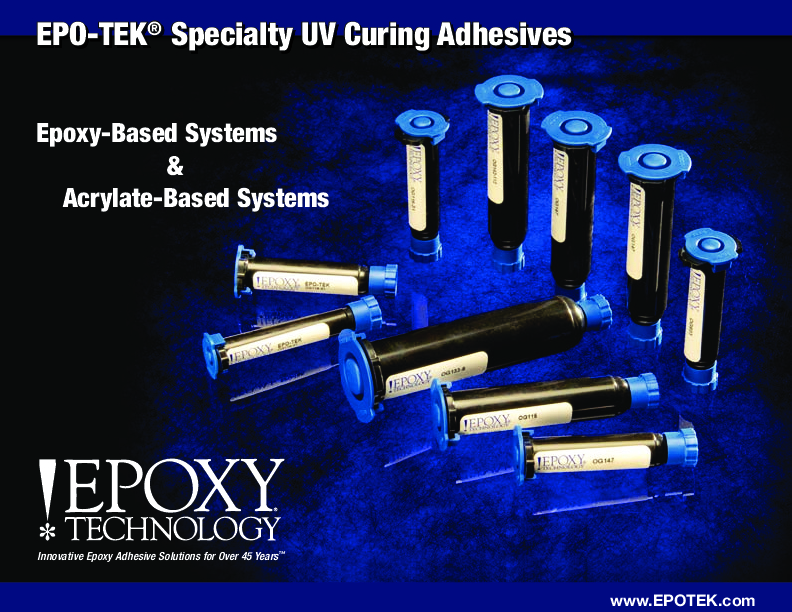
Epoxy Technology, Inc. offers a complete line of high performance Ultraviolet (UV) cure adhesives ranging in viscosity, flexibility, refractive index and light transmission.
Selected Application- Glob Top
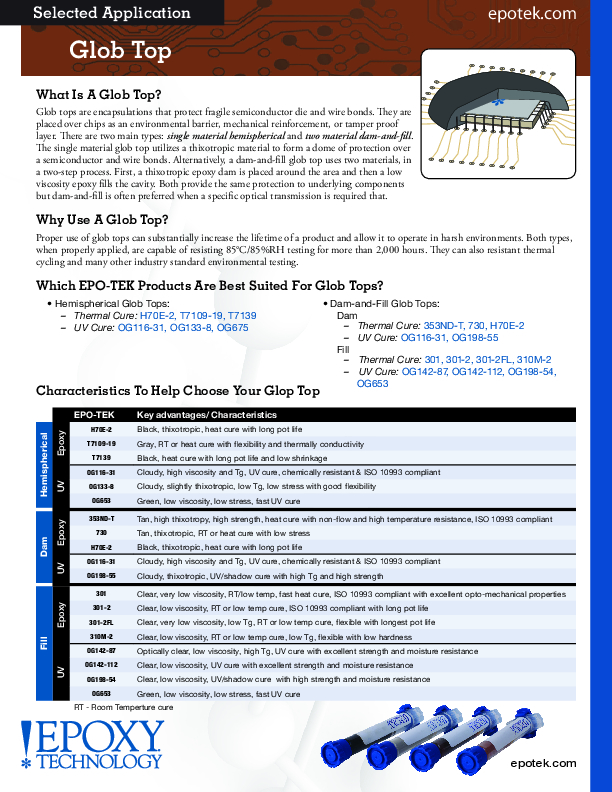
Glob Top Application Guide Epoxy Technology offers a wide selection of optical, thermal and UV epoxies needed for glob top applications. These materials are grouped by the two main types of glob tops: single material hemispherical and two material dam-and-fill.
EPO-TEK® Halogen Free Epoxies
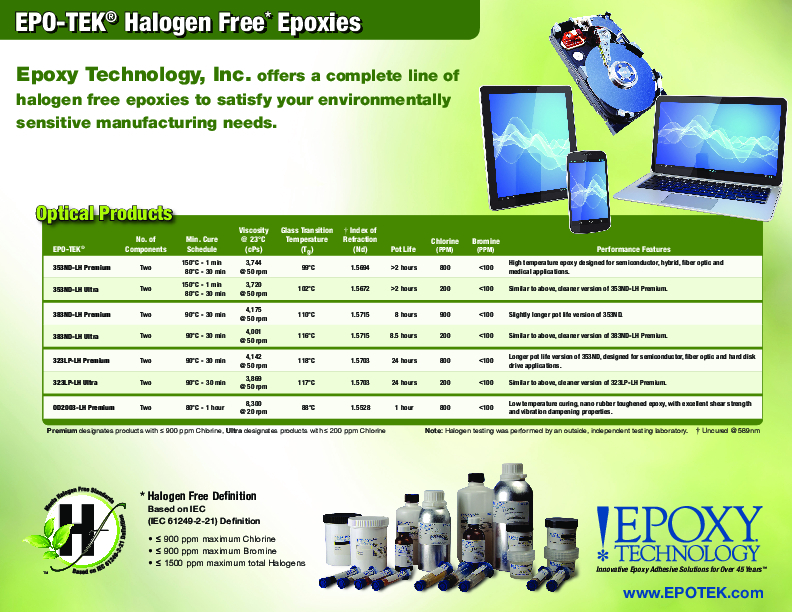
Epoxy Technology offers New Halogen Free* Epoxy Adhesives. These products conform to environmental regulations and provide corrosion or electromigration resistance for high reliability electronic applications.
Custom Solutions for the Dynamic Advancement of the Electric Vehicle Market
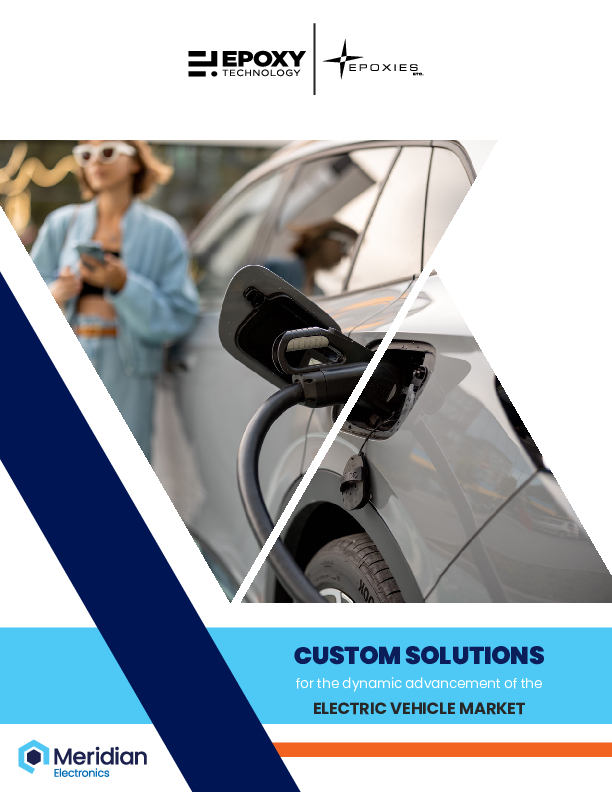
Epoxy Technology and Epoxies, Etc are working together to provide enhanced solutions to the Electric Vehicle Market. Epoxy, urethane, silicone and UV materials have been used in some of the most demanding applications which include battery & component assembly, EV chargers, transformer potting along with a variety of others.
EPO-TEK® Selector Guide
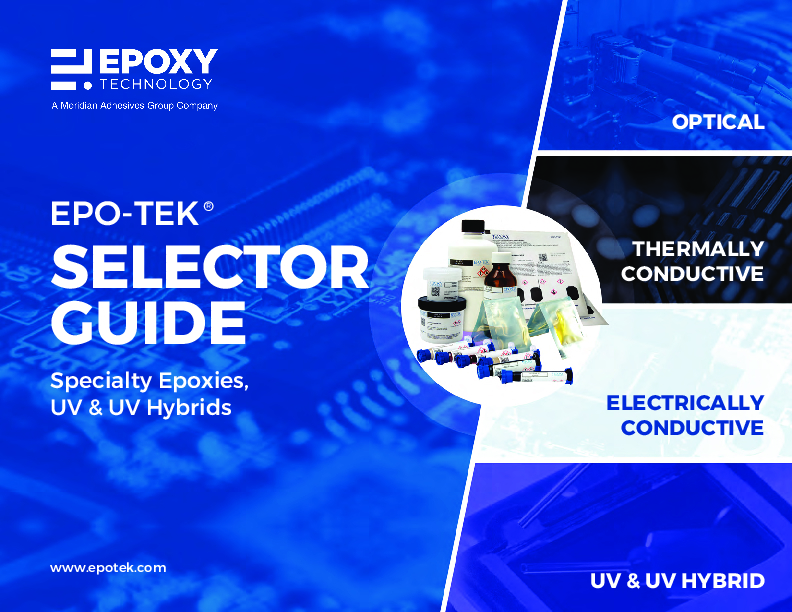
Detailed product information on our specialty adhesive product lines: Optical Adhesives, Electrically Conductive Adhesives (ECA), Thermally Conductive Adhesives (TCA), UV & UV Hybrids.
EPO-TEK® 353ND Family of Products Selector Guide
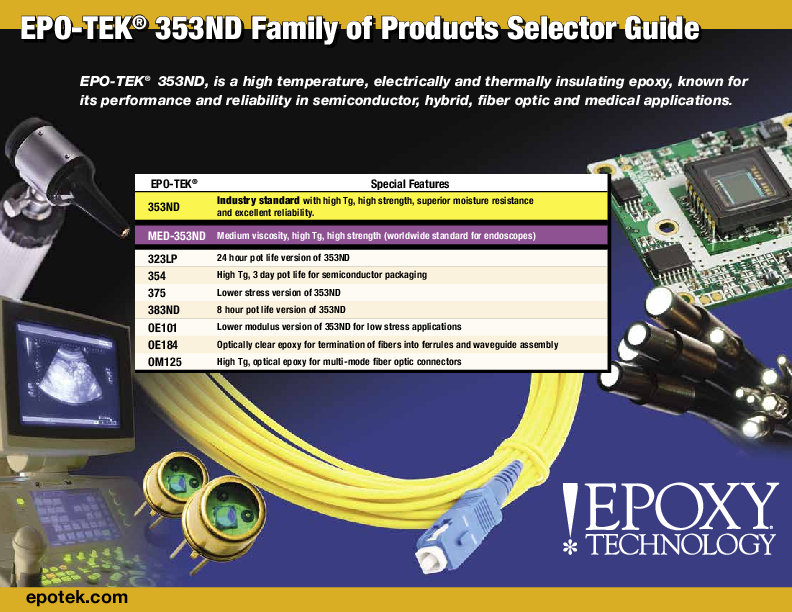
Epoxy Technology presents a new comparative piece focused on the industry standard, EPO-TEK® 353ND, and it's related family of products used in semiconductor, hybrid, fiber optic and medical applications. This is a visual and informative piece showing where each product falls based on a variety of physical properties.
EPO-TEK® 353ND Family of Products for Fiber Optics
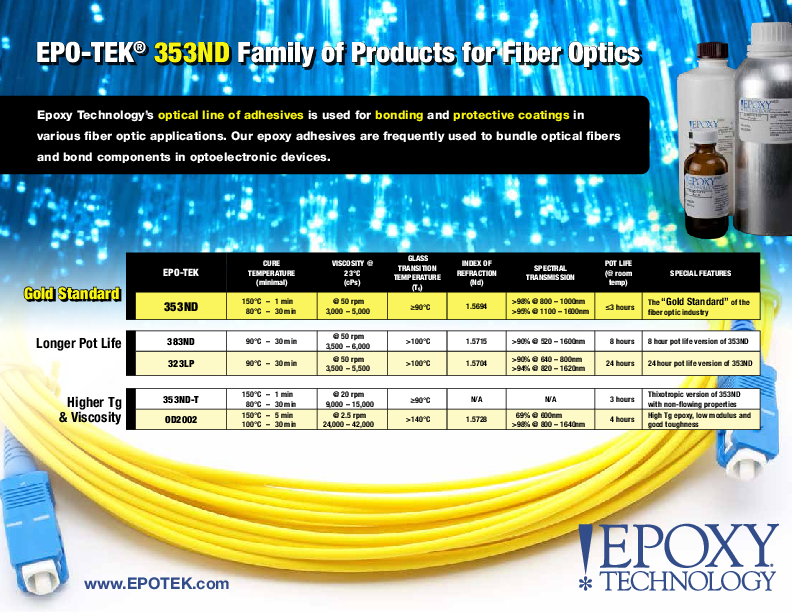
Epoxy Technology's optical line of adhesives are used for bonding and protective coatings in various fiber optic applications. Our epoxy adhesives are frequently used to bundle optical fibers and bond components in optoelectronic devices.
How to Interpret a Datasheet
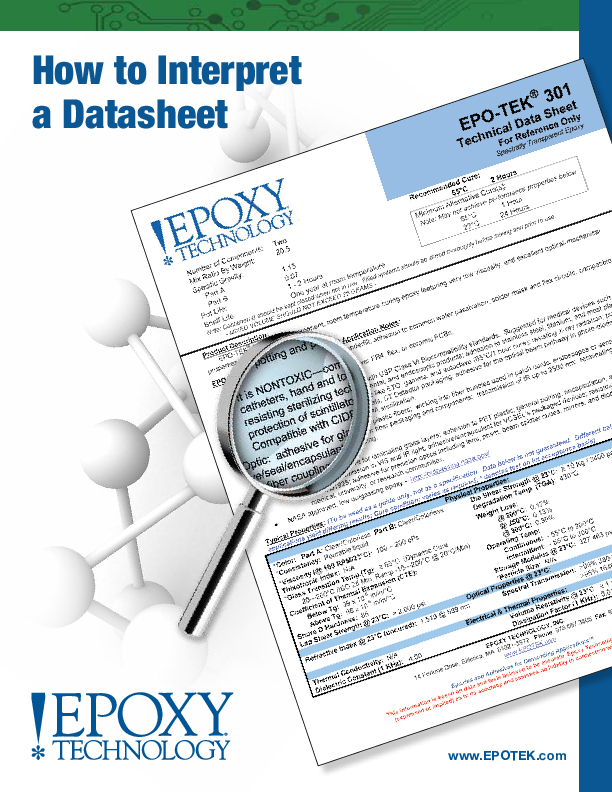
How to Interpret a Datasheet When selecting an EPO-TEK® product for any application, the datasheet provides excellent information, and is a useful first reference guide. It is therefore important that the datasheet be correctly interpreted in order to achieve the expected properties and to avoid problems with any given product.
EPO-TEK® Adhesives Applications (PCB)
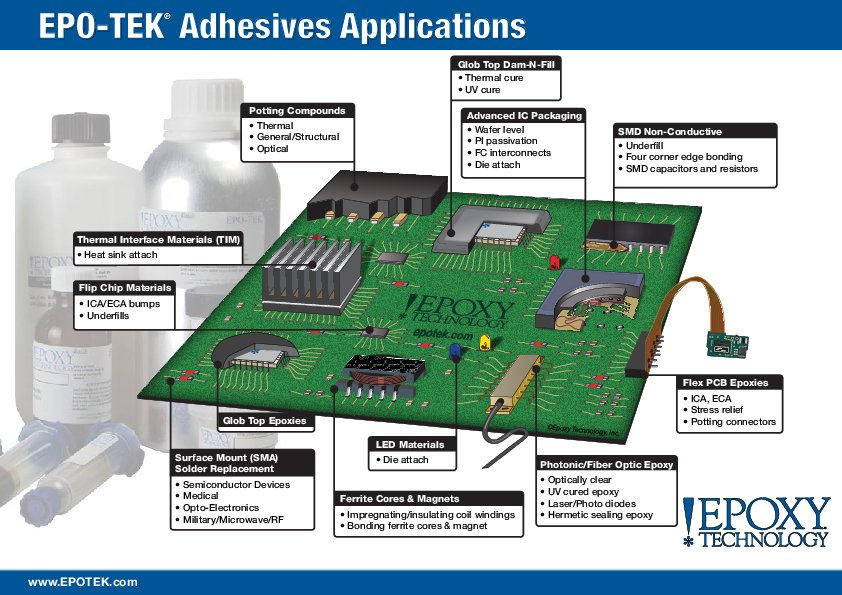
Epoxy Technology announces its latest offering for epoxy adhesive selection, our PCB Applications Guide. Applications include: IC Packaging, Ferrite Cores & Magnets, Flex PCB, Flip Chip, Glob Top, Glob Top Dam-N-Fill, LED, Photonic/Fiber Optic, Potting Compounds, SMD Non-Conductive, Surface Mount Adhesives/Solder Replacements and Thermal Interface Materials.
EPO-TEK® World Class LED Adhesives

Epoxy Technology showcases their extensive line of LED adhesives for both Low Power (LP) and High Power (HP) LED systems. These products include electrically conductive, thermally conductive and electrically & thermally conductive materials.
EPO-TEK® Adhesives for Concentrated Photo Voltaic (CPV)
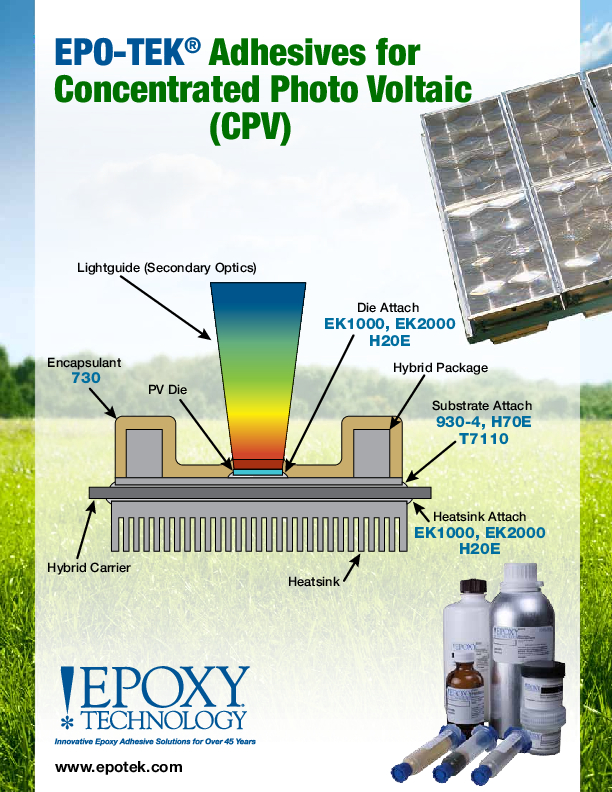
Epoxy Technology offers a variety of specialty adhesives for your Concentrated Photo Voltaic (CPV) applications.
HI-REL Die Attach Adhesives
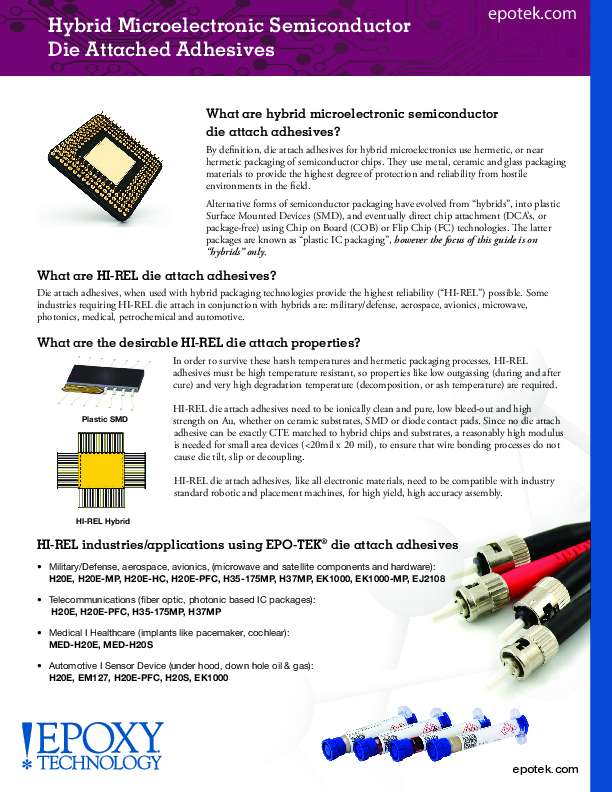
HI-REL Die Attach Adhesives Epoxy Technology reviews Hi-REL die attach adhesives, desirable properties, applications and adhesive selection including steps to be considered when choosing a Hi-REL adhesives, and a listing of products available with MSL1 test results.
EPO-TEK® Adhesives for Solar Applications
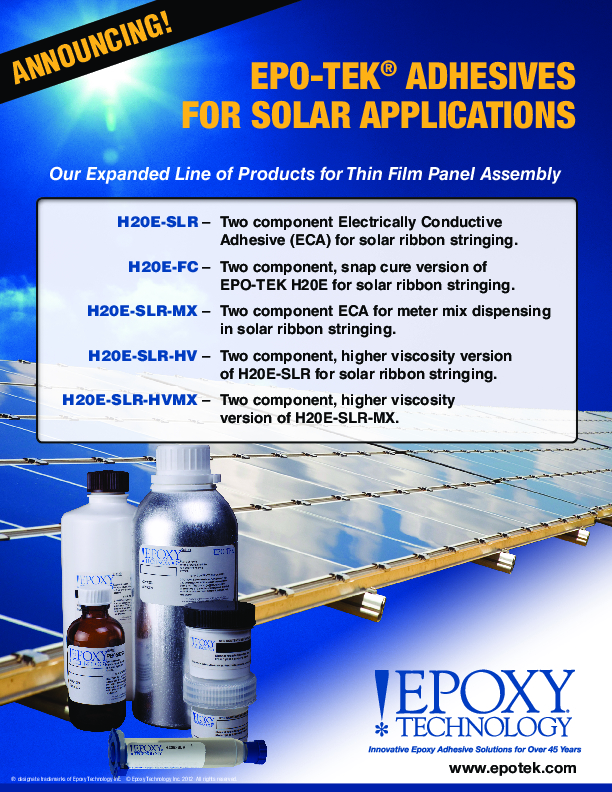
Epoxy Technology announces an expanded line of solar adhesive products for thin film panel assembly.
Epoxy Adhesive Test Measurement Guide
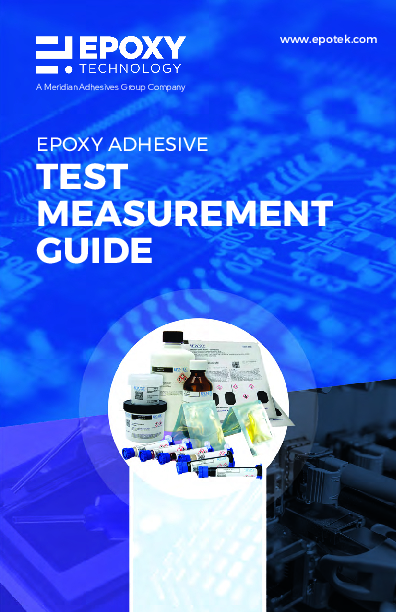
Epoxy Technology offers this educational tool designed to assist adhesive users in gaining a more thorough understanding of adhesive properties and testing. The information contained within this guide is useful and invaluable for choosing the best adhesive in your specific application.
EPO-TEK® Biocompatible Medical Device Grade Products
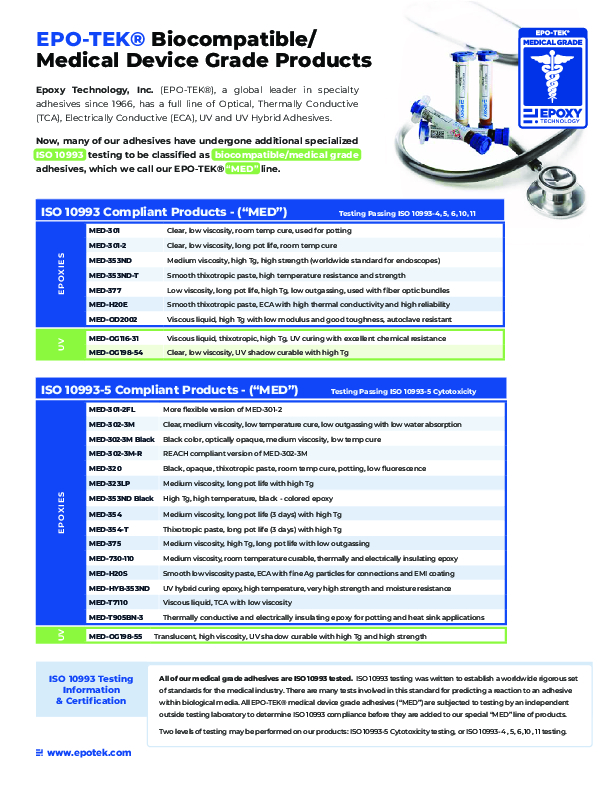
01905000 Epoxy Technology, Inc. showcases its comprehensive line of EPO-TEK® Biocompatible/ Medical Adhesives & Encapsulant (“MED”) products. All EPO-TEK® MED products have undergone specialized ISO 10933 testing from an independent outside testing laboratory. This medical device adhesives brochure provides detailed adhesive property information as well as product specific recommendations for many medical applications including sensors, instruments, hearing aids, dental equipment, pacemakers, endoscopes and catheter products.
Hybrid Chemistry Adhesives For Optoelectronics
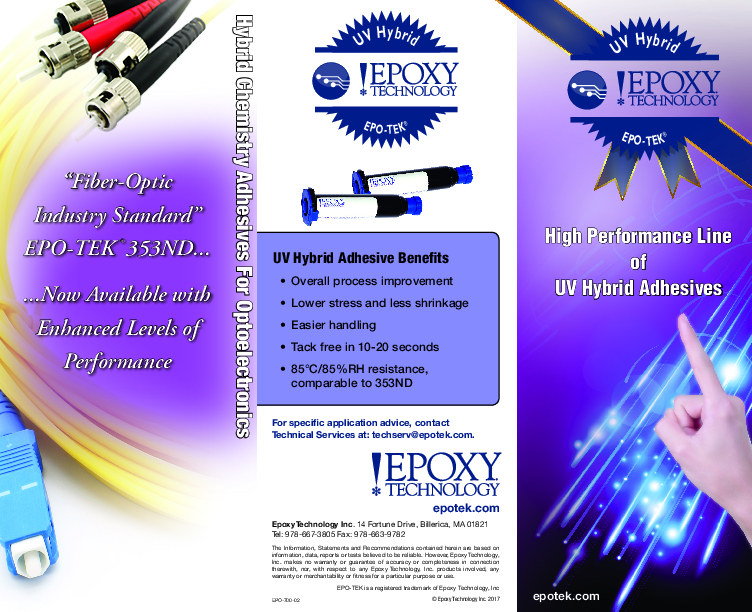
Hybrid Chemistry Adhesives For Optoelectronics UV Hybrid Adhesive Performancefrom EPO-TEK®“Fiber-Optic Industry Standard”EPO-TEK® 353ND... ...Now Available with Enhanced Levels of Performance
EPO-TEK® Camera Module, ADAS, LiDAR

EPO-TEK® specialty adhesives for photonics, featuring optical transmission, thermal management, active alignment and NASA/MIL-STD/Telcordia-certified low-outgassing solutions.
Highly Engineered & Enhanced Dispensing Products
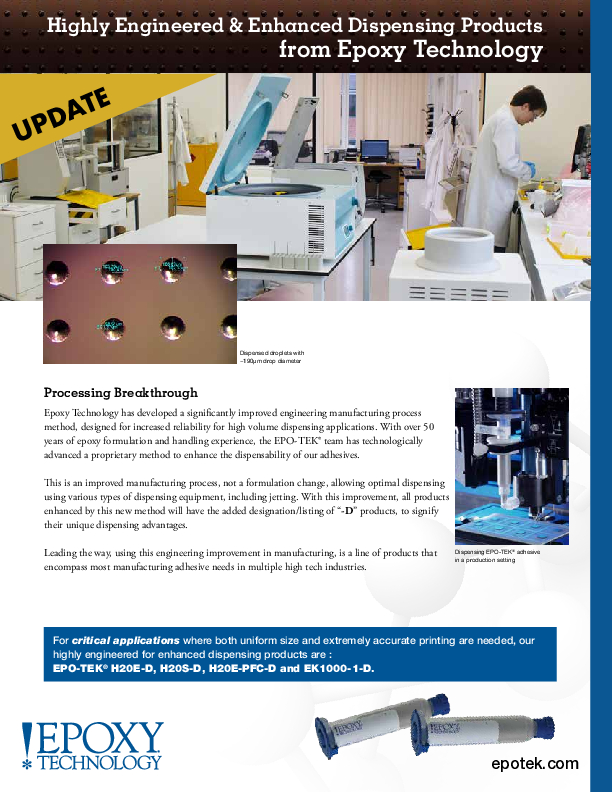
Highly Engineered & Enhanced Dispensing Products Utilizing a significantly improved engineering manufacturing process method, Epoxy Technology offers adhesives with Enhanced Dispensed Properties (designated/listed as “-D”). These materials increase the reliability of high volume dispense applications by minimizing the potential for skips or misses in the dispense process, while allowing for smaller and more accurate dot sizes.
EPO-TEK® Epoxies for Haptic Applications
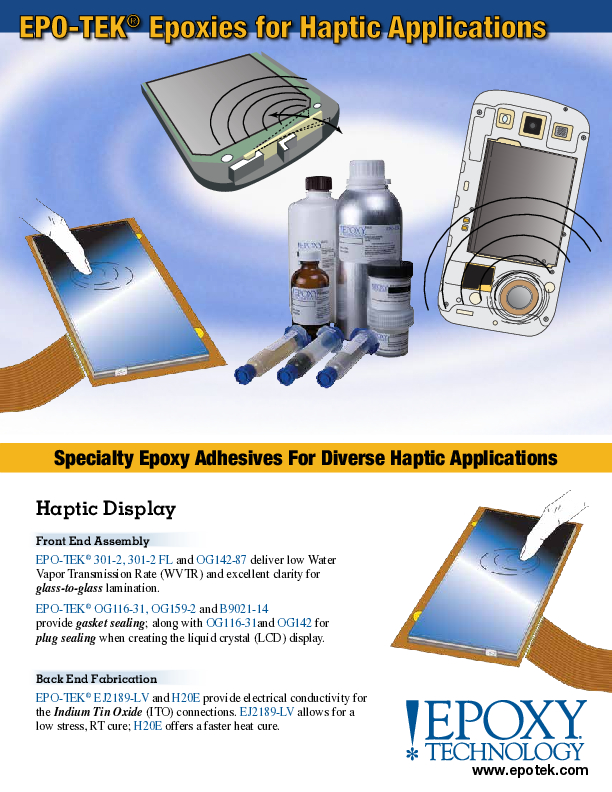
From front end assembly...to back end display manufacturing, Epoxy Technology provides specialized epoxy adhesives for touch applications including: touch, gesture & motion, multi-touch & haptic display markets. These products are formulated for exceptional quality and reliability.
Introducing EPO-TEK® 343ND-LH
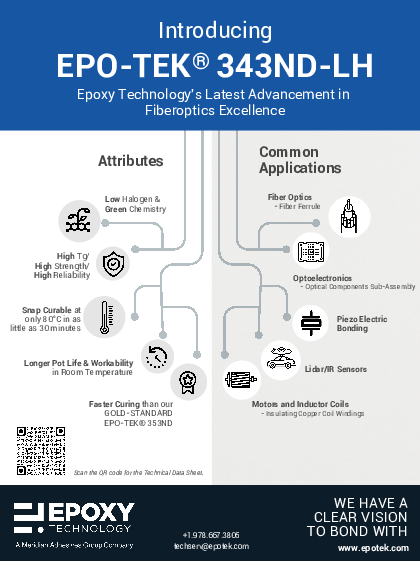
Epoxy Technology’s Latest Advancement in Fiberoptics Excellence, EPO-TEK® 343ND-LH, for your fiber optic and semiconductor applications.
EPO-TEK® Epoxies for Solar Applications
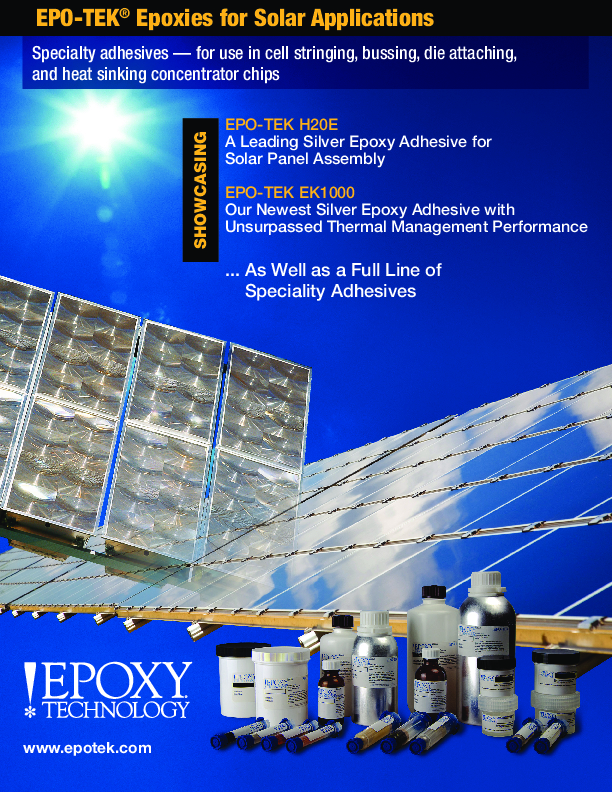
Epoxy Technology products have been selected by top solar panel manufacturers due their well documented and extensive use in thermal management applications and proven reliable over many years of service.
EPO-TEK® Specialty Adhesives for Sensor Applications
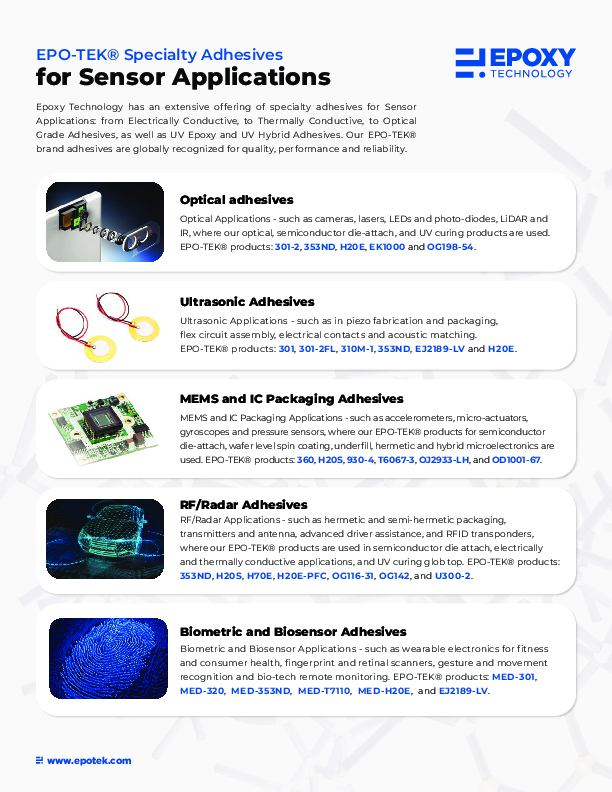
Learn more about our specialty adhesives for sensor applications.
Epoxy Technology Announces EPO-TEK® EK1000 & EPO-TEK® EK2000
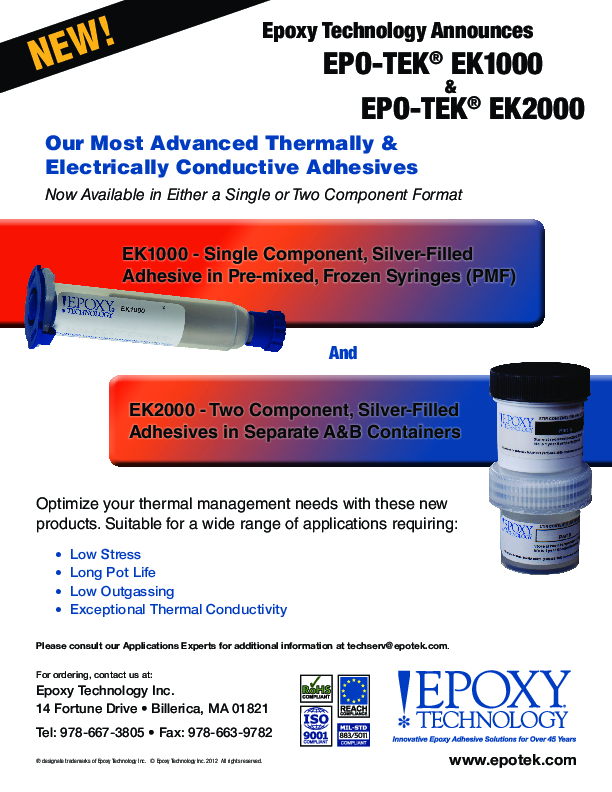
Epoxy Technology announces EPO-TEK® EK1000 & EPO-TEK® EK2000. These new silver filled adhesives exhibit exceptional thermal & electrical conductivity and are now available in either a single or two component format.
How to Work Properly with Epoxies- Step by Step Instructions
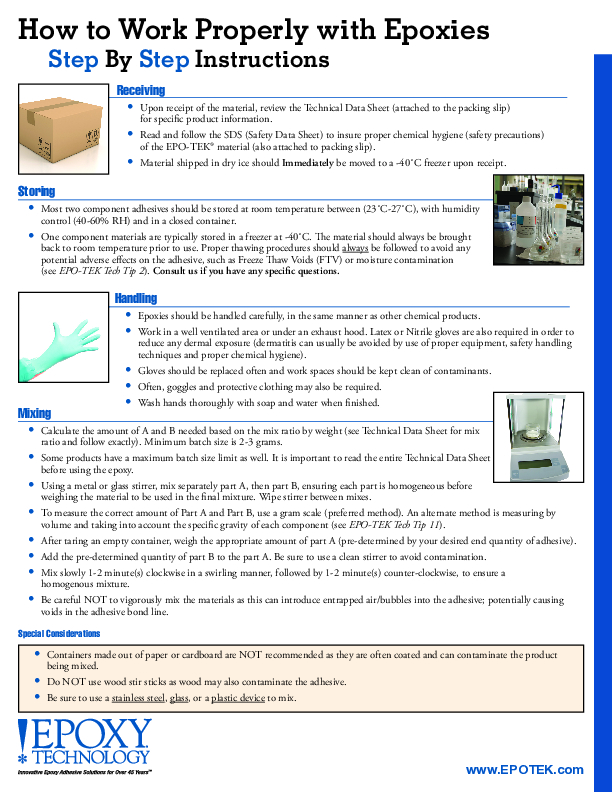
How To Work Properly With Epoxies - Step by Step Sheet Epoxy Technology announces its new instructional sheet on how to work properly with epoxies from initial receipt of the material, appropriate storage & handling, surface preparation, mixing, applying as well as choosing the most applicable cure profile.
Also available in: German FrenchNext Generation Hybrid Chemistry Adhesives for Optoelectronics
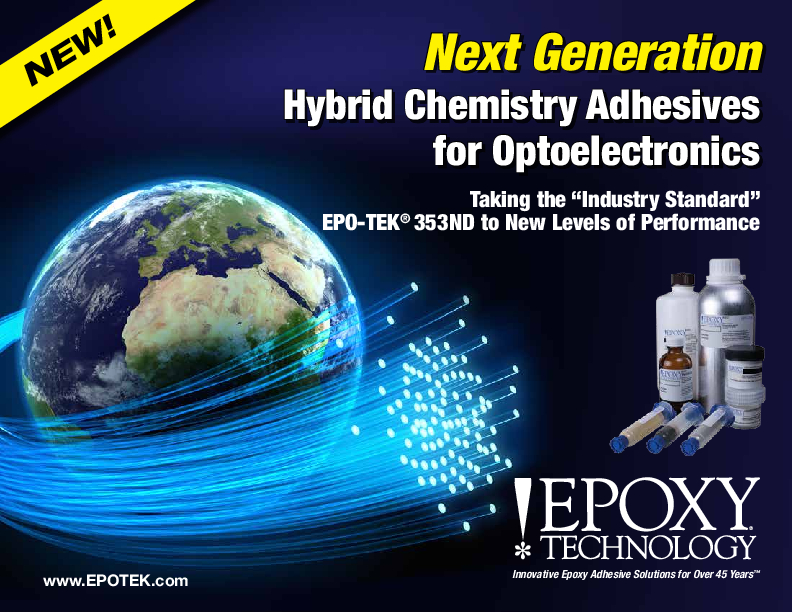
Next Generation Hybrid Adhesives Epoxy Technology, Inc. presents our new Epoxy/UV Hybrid Adhesives for Optoelectronics based on the "Industry Standard" EPO-TEK® 353ND. This piece highlights three new hybrid products that allow initial UV tacking, followed by a thermal cure for overall process improvement, ease of handling and higher thru-put.
Optimizing Thermal Management… with EPO-TEK® Thermally Conductive Adhesives
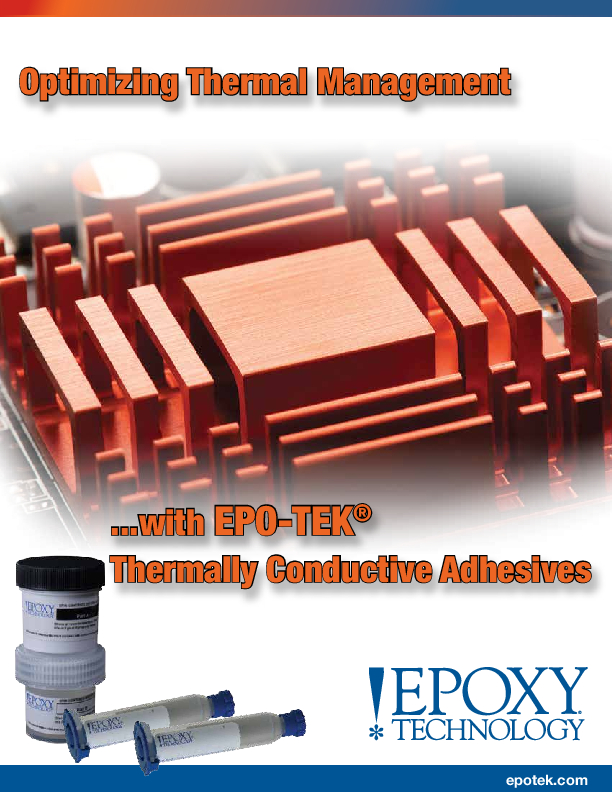
Thermal Management Brochure Epoxy Technology presents a comprehensive overview of thermal conductivity & management using EPO-TEK® products. It highlights our most advanced products: EPO-TEK® EK1000, EK1000-1 & EK2000. These cutting-edge, silver-filled adhesives exhibit exceptional thermal/electrical conductivity and provide superior performance in high reliability applications.
Pre-Mixed Frozen Syringe Packaging
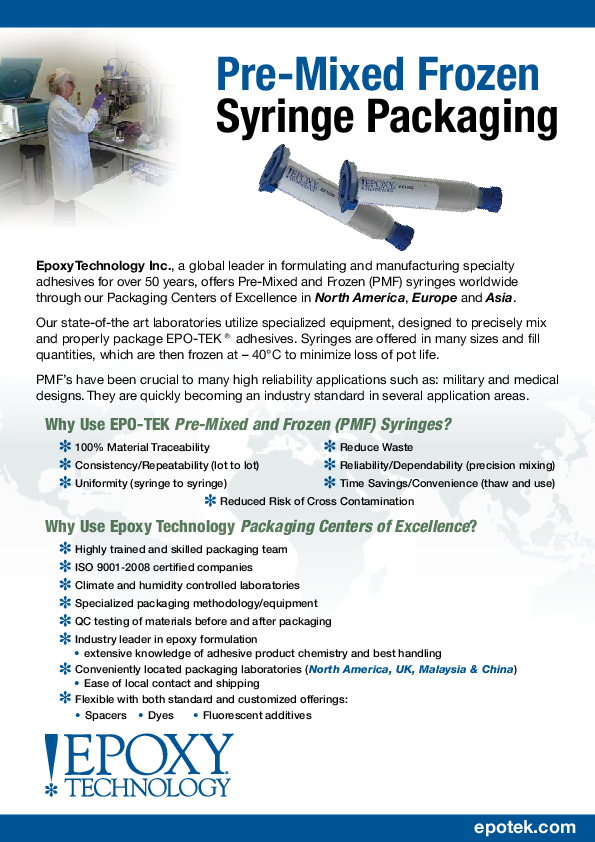
Syringe Packaging Epoxy Technology announces our worldwide syringe packaging capabilities with certified laboratories in North America, Europe and Asia. All locations utilize our specialized packaging equipment. With extensive experience in epoxy formulation and handling, we are able to best package EPO-TEK® materials for optimal p
Also available in: German FrenchSelected Application- Biocompatibility Testing of Adhesives
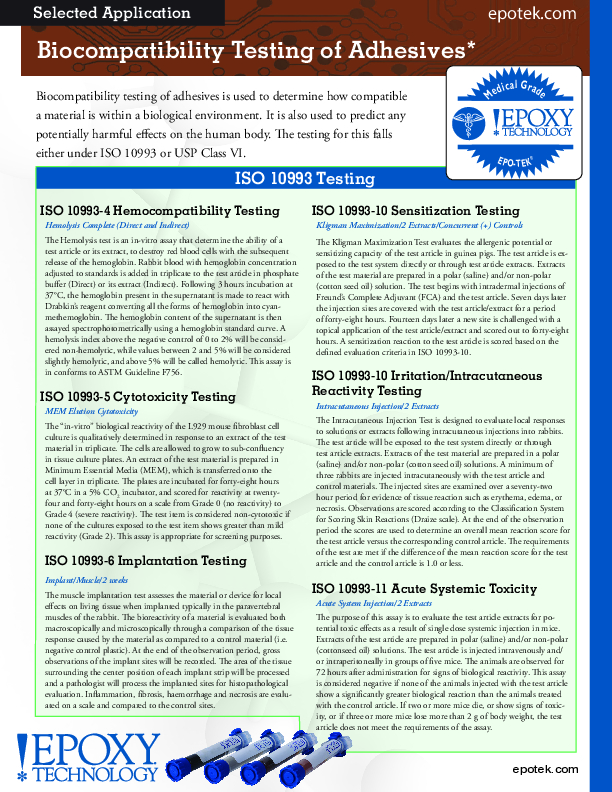
Biocompatibility Testing of Adhesives Biocompatibility testing of adhesives is used to determine how compatible a material is within a biological environment. It is also used to predict any potentially harmful effects on the human body. The testing for this falls either under ISO 10993 or USP Class VI.
Selected Application- Cryogenic Temperature and Epoxies
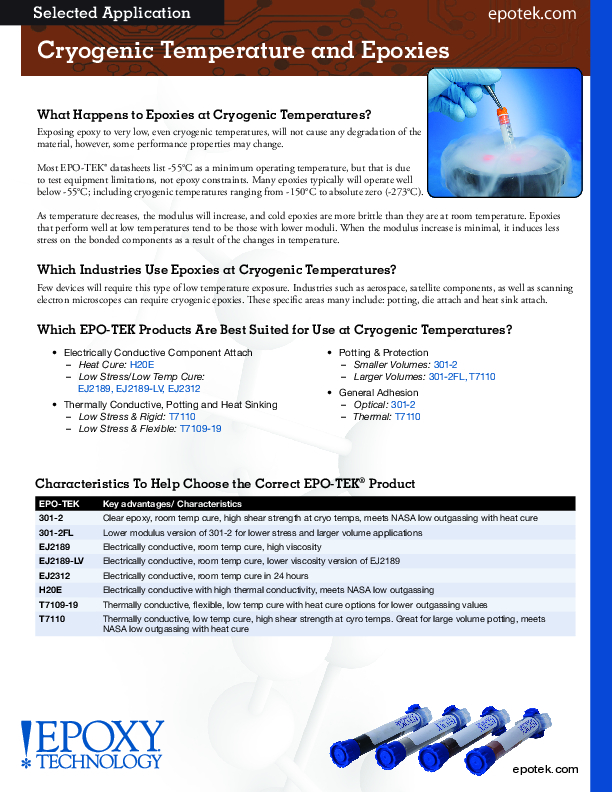
Cryogenic Temperatures and Epoxies Epoxy Technology provides optical, thermally conductive and electrically conductive adhesives for a variety of cryogenic applications. This piece discusses what happens to epoxies at these temperatures and which EPO-TEK® products are best suited for this environment.
Selected Application- Down-Hole Applications
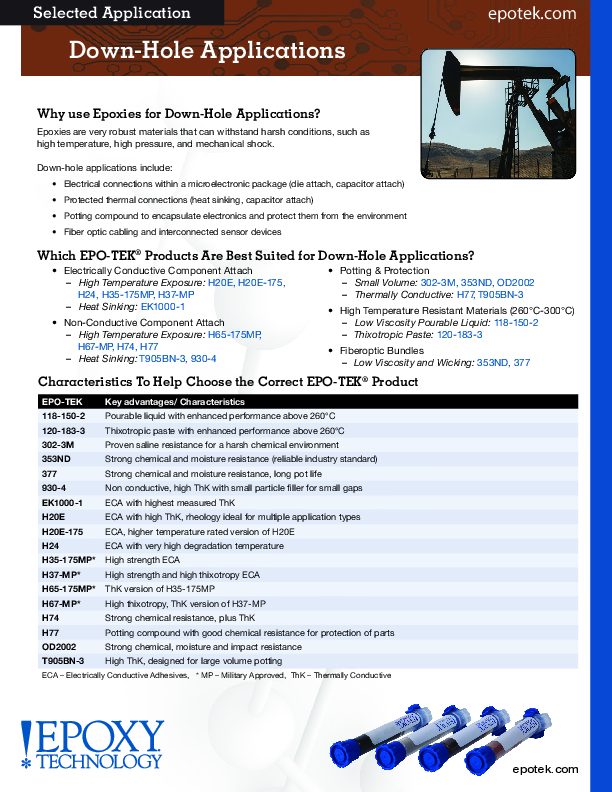
Epoxy Technology presents various high temperature epoxies suited for down-hole applications that include die attach, heat sinking, capacitor attach, potting, fiber optics & sensors.
Selected Application- Fiber to Ferrule Bonding
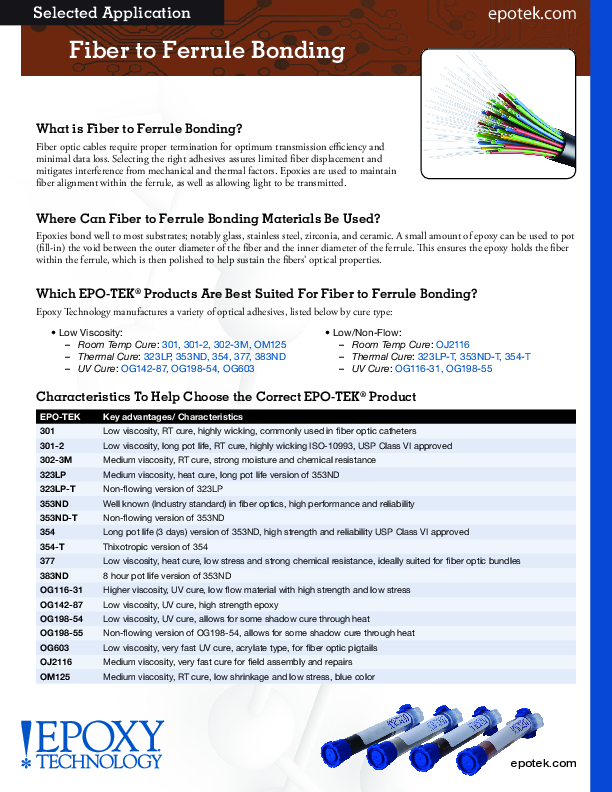
0-3175Epoxy Technology offers several optical adhesives for fiber to ferrule bonding. These products range from high to low viscosity and are grouped by the following cure types: room temperature, thermal and UV.
Tech Tip 13 Surface Preparation
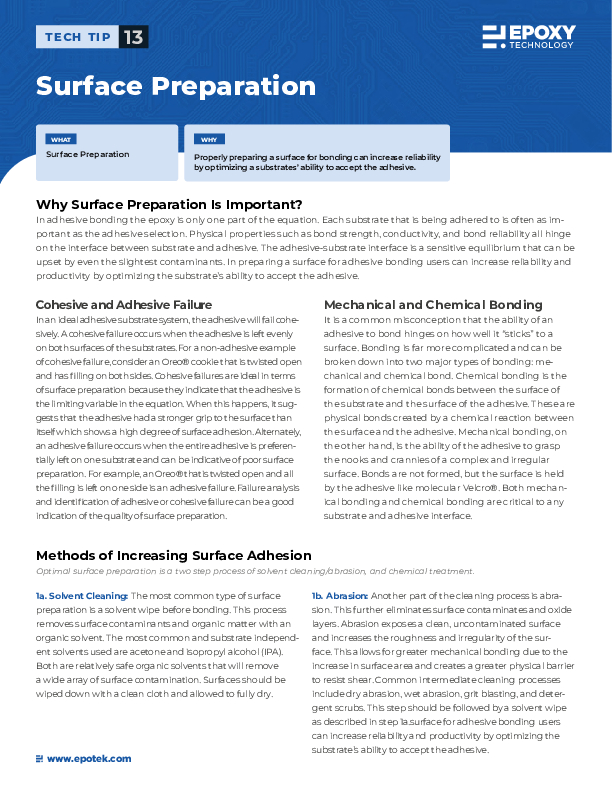
Tech Tip 13 - Surface Preparation What: Surface Preparation Why: Properly preparing a surface for bonding can increase reliability by optimizing a substrates’ ability to accept the adhesive.
Also available in: GermanSelected Application- Hard Disk Drive Assembly
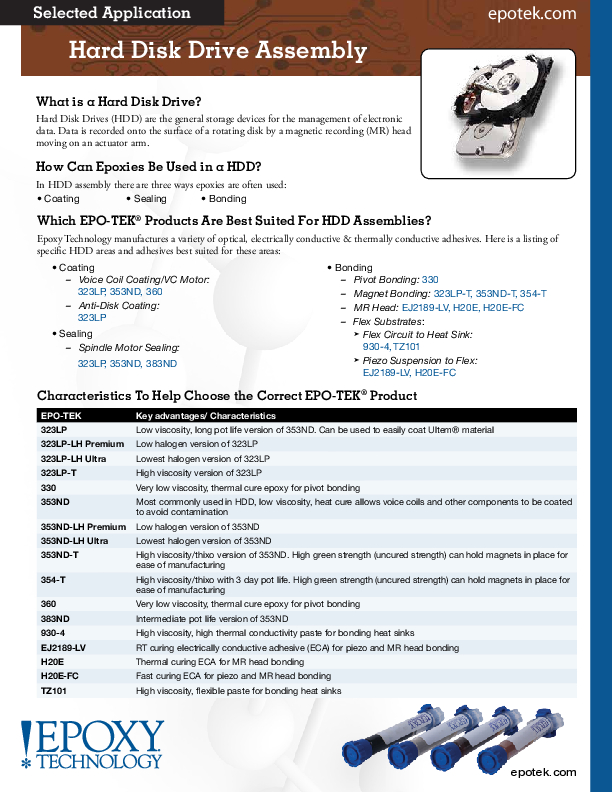
Hard Disk Drive Application Guide Epoxy Technology specializes in a large selection of epoxies (including low halogen materials) used in many coating, sealing and bonding applications required in hard disk drives.
Tech Tip 20 B-stage Epoxy
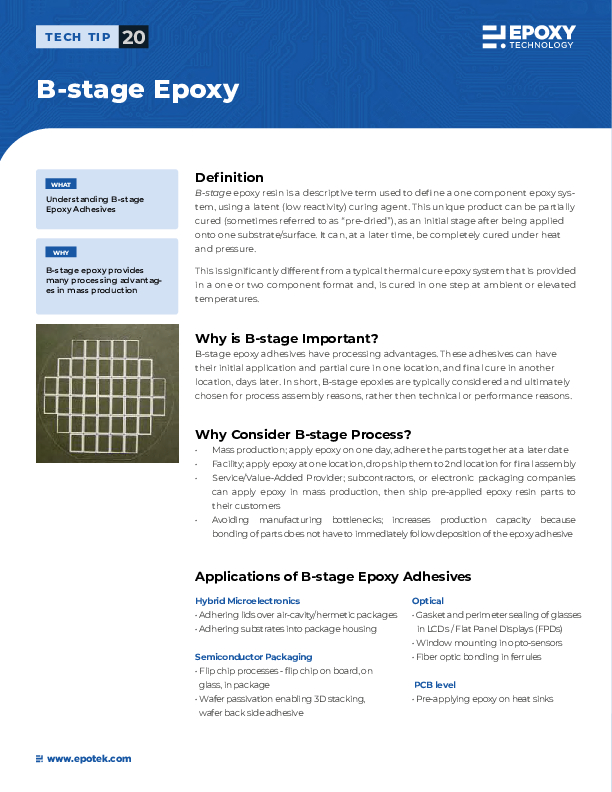
B-stage Epoxy What: Understanding B-stage Epoxy Adhesives Why: B-staged epoxy provides many processing advantages in mass production
Also available in: GermanSelected Application- Jewelry and Watches US
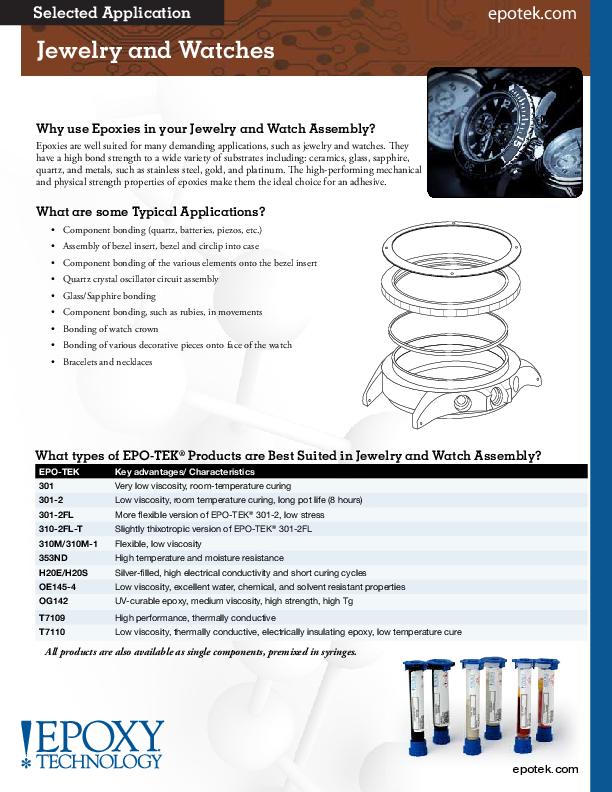
Jewelry and Watches Epoxy Technology offers adhesives for jewelry and watch applications. The high-performing mechanical and physical strength properties of epoxies make them the ideal choice.
Selected Application- Preservation and Restoration
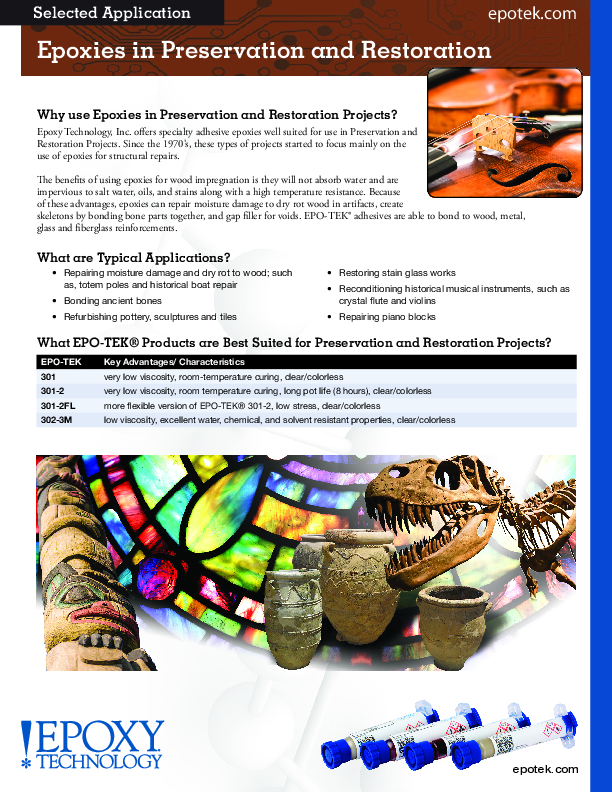
Epoxies in Preservation and Restoration Epoxy Technology offers specialty adhesive epoxies well suited for use in Preservation and Restoration Projects.
Tech Tip 11 Converting Mix Ratios
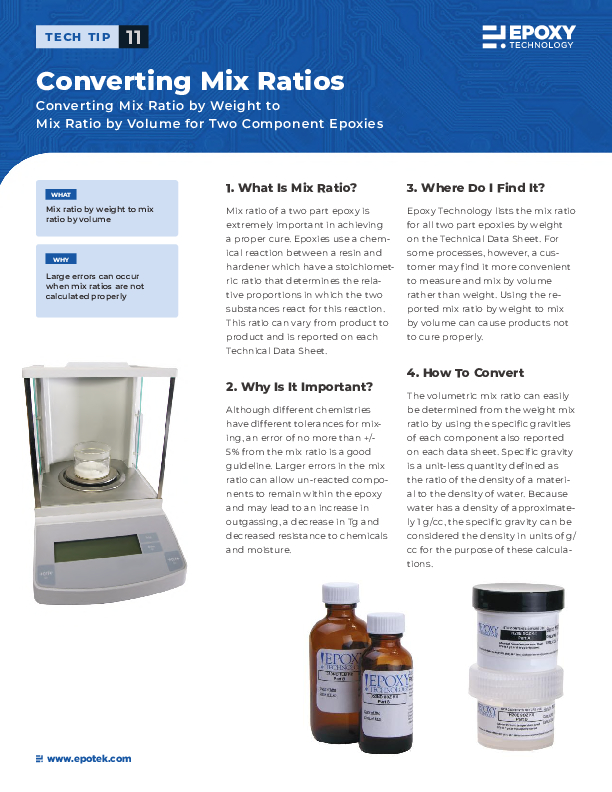
Converting Mix Ratios What: Mix ratio by weight to mix ratio by volume Why: Large errors can occur when mix ratios are not calculated properly
Also available in: German FrenchSelected Application- Ribbon Stringing with Epoxies
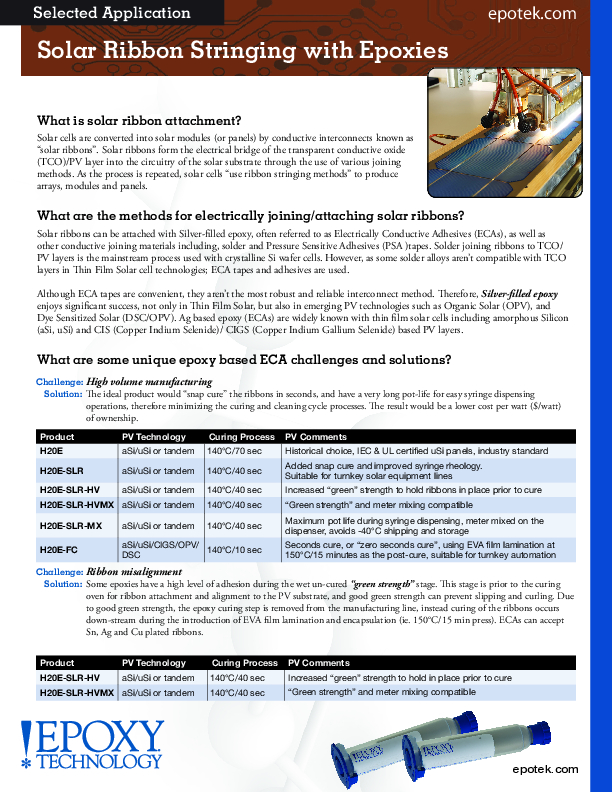
Solar Ribbon Stringing with Epoxies Solar ribbons can be attached with Silver-filled epoxy, often referred to as Electrically Conductive Adhesives (ECAs), as well asother conductive joining materials including, solder and Pressure Sensitive Adhesives (PSA) tapes. Solder joining ribbons to TCO/PV layers is the mainstream process used with crystalline Si wafer cells.
Selected Application- Ultrasonic Applications
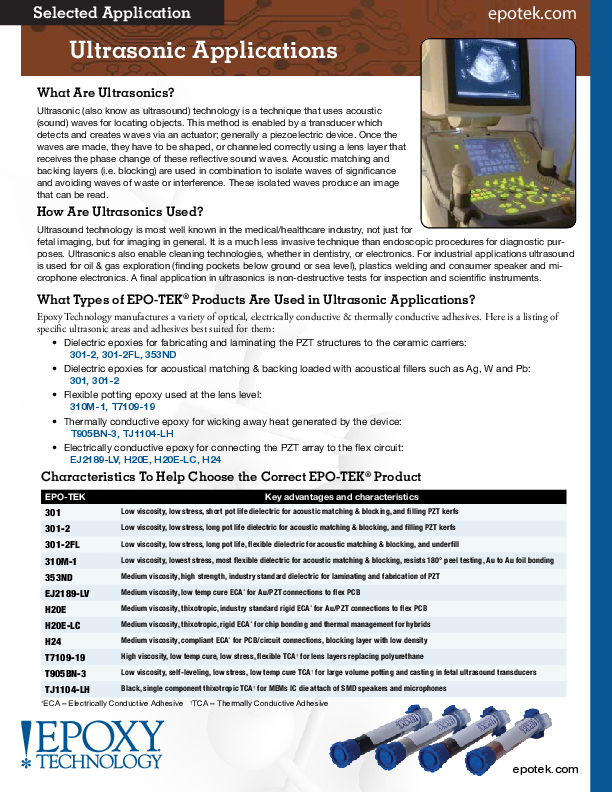
Ultrasonic Application Guide Epoxy Technology provides optical, thermally conductive and electrically conductive adhesives for ultrasound technology in the medical/heathcare, electronics, oil & gas and non-destructive testing fields.
Selected Application- Underfills
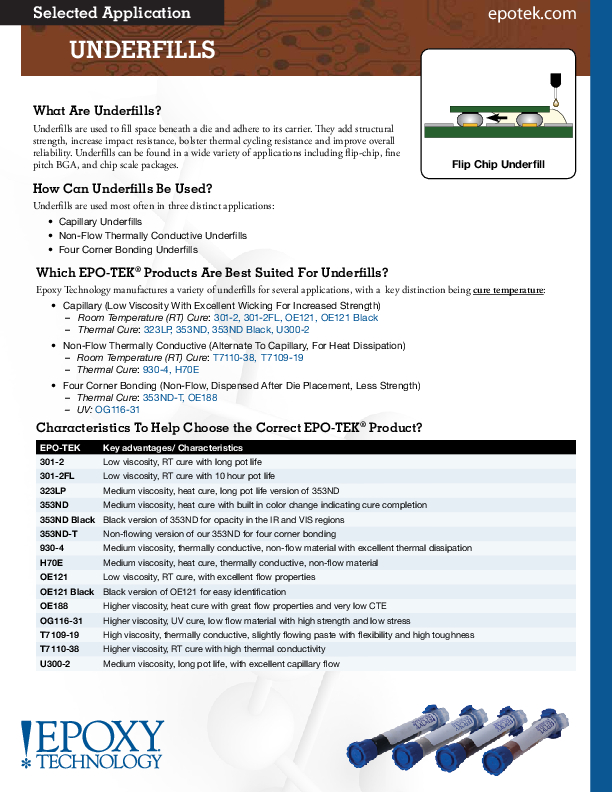
Underfill Guide Epoxy Technology manufactures a variety of underfills for several applications, with a key distinction being cure temperature.
Tech Tip 21 Epoxy & Silicone Interactions
Tech Tip 21 - Epoxy & Silicone Interactions What: Epoxy and Silicone Interactions Why: Epoxies and Silicones can co-exist favorably within the same application when applied properly.
Also available in: GermanTech Tip 1 Proper Mixing & Handling of Epoxies
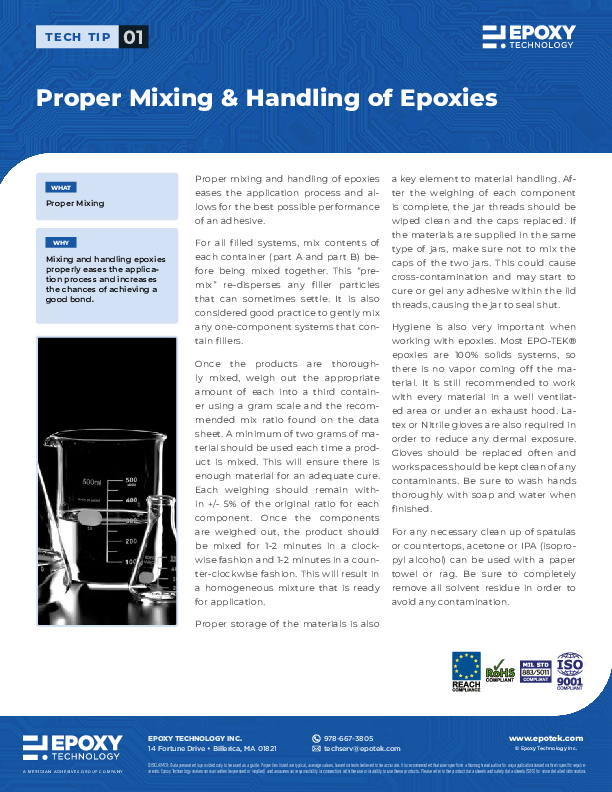
Tech Tip 1 - Proper Mixing and Handling of Epoxies What: Proper Mixing Why: Mixing and handling epoxies properly eases the application process and increases the chances of achieving a good bond.
Also available in: German FrenchTech Tip 27 Polyimides
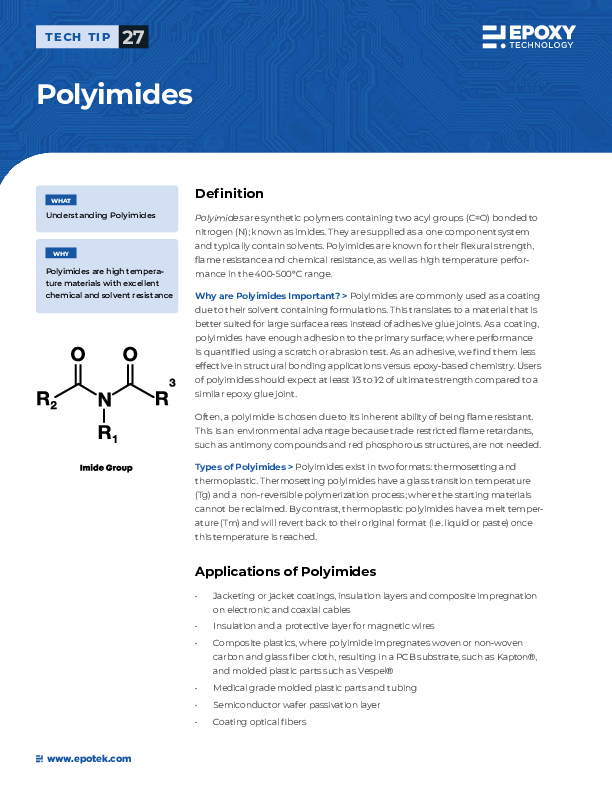
Tech Tip 27 - Polyimides What: Understanding Polyimides Why: Polyimides are high temperature materials with excellent chemical and solvent resistance
Also available in: GermanTech Tip 10 Component Selections for Optimal Dispensing of Epoxies
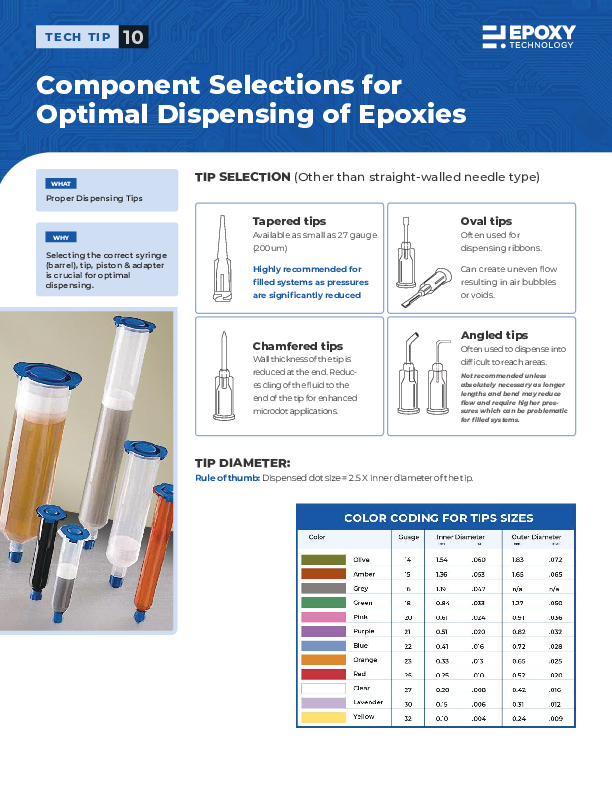
Component Selections for Optimal Dispensing of Epoxies What: Proper Dispensing Tips Why: Selecting the correct syringe (barrel), tip, piston & adapter is crucial for optimal dispensing.
Also available in: German FrenchTech Tip 2 Handling Procedures for Premixed & Frozen Materials
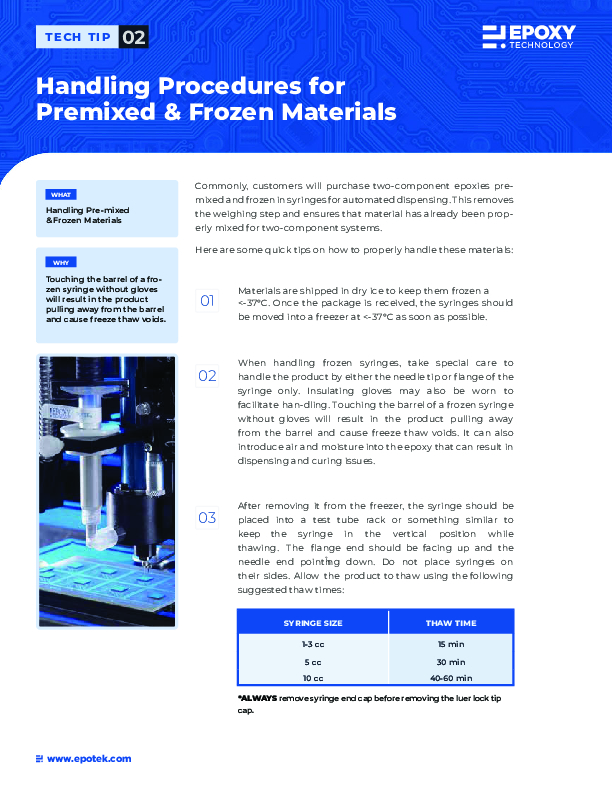
Handling Premixed and Frozen Materials What: Handling Premixed & Frozen Materials Why: Touching the barrel of a frozen syringe without gloves will result in the product pulling away from the barrel and cause freeze thaw voids.
Also available in: German FrenchTech Tip 12 Compatible Metallization with Electrically Conductive Silver Epoxies
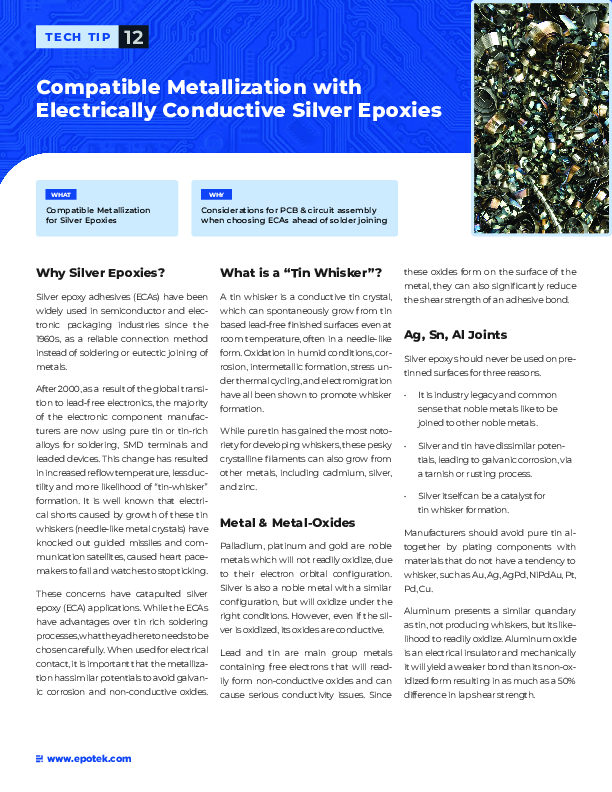
Tech Tip 12 - Compatible Metallization What: Compatible Metallization for Silver Epoxies Why: Considerations for PCB & circuit assembly when choosing ECAs ahead of solder joining
Also available in: GermanTech Tip 23 Tg – Glass Transition Temperature for Epoxies
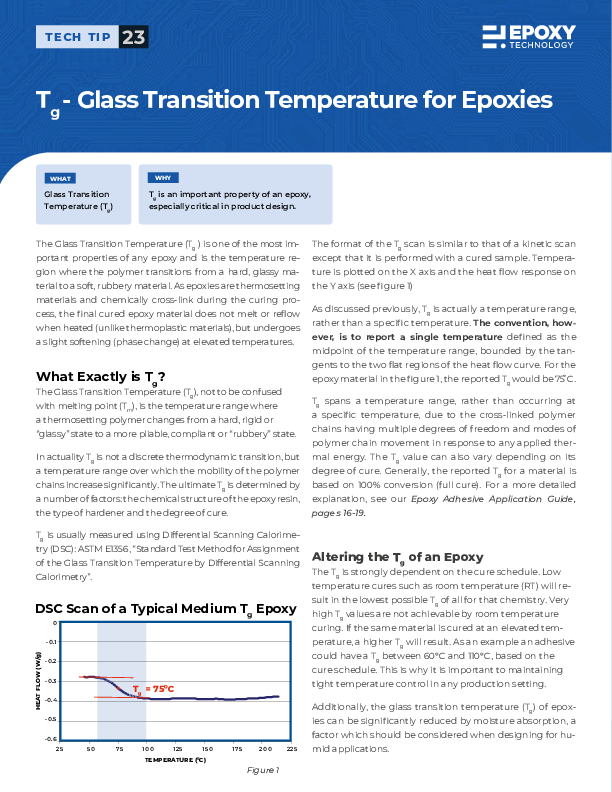
Glass Transition Temperature for Epoxies What: Glass Transition Temperature (Tg) Why: Tg is an important property of an epoxy, especially critical in product design.
Also available in: GermanTech Tip 14 Understanding Acceptable Epoxy Color Variations
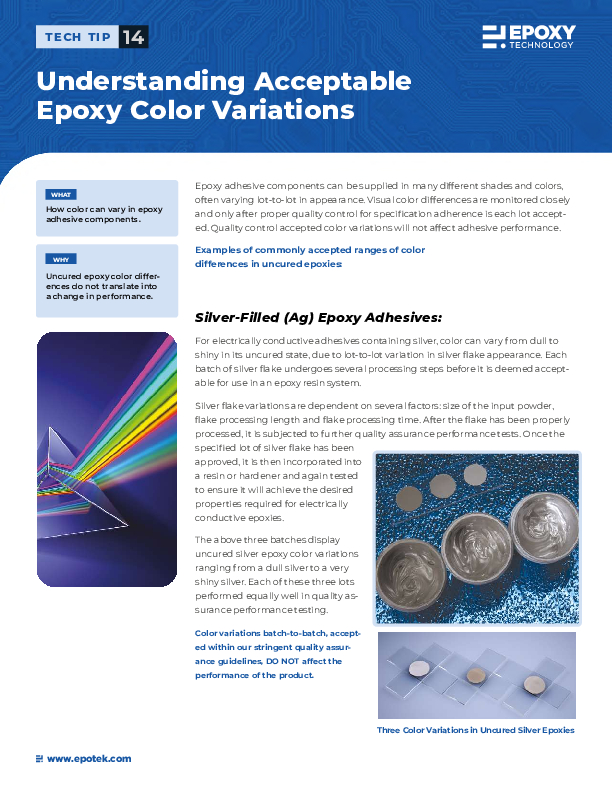
Tech Tip 14 - Color Variations What: How color can vary in epoxy adhesive components. Why: Uncured epoxy color differences do not translate into a change in performance.
Also available in: German FrenchTech Tip 19 Understanding Mechanical Properties of Epoxies For Modeling, Finite Element Analysis (FEA)
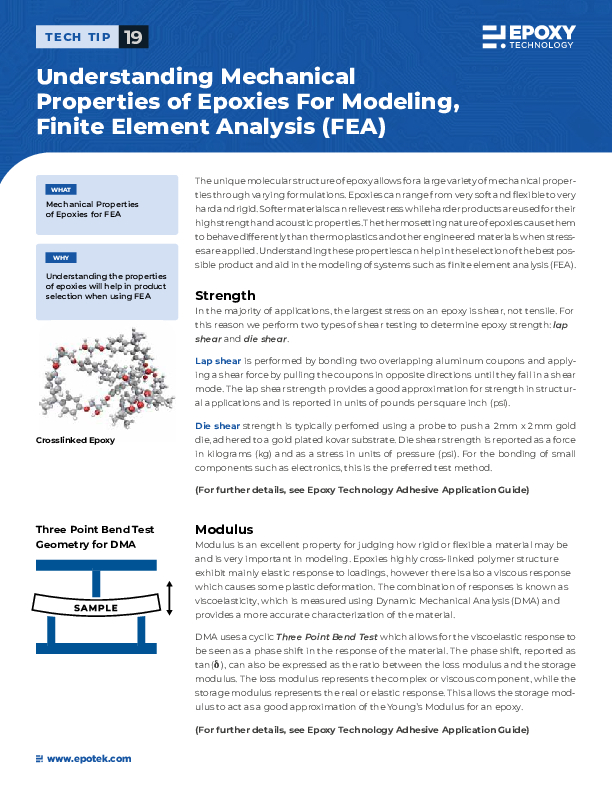
Tech Tip 19 - Understanding Mechanical Properties of Epoxies for FEA What: Mechanical Properties of Epoxies for FEA Why: Understanding the properties of epoxies will help in product selection when using FEA
Also available in: GermanTech Tip 15 The Effect of Relative Humidity and Temperature on VR for Room Temperature Curing ECAs
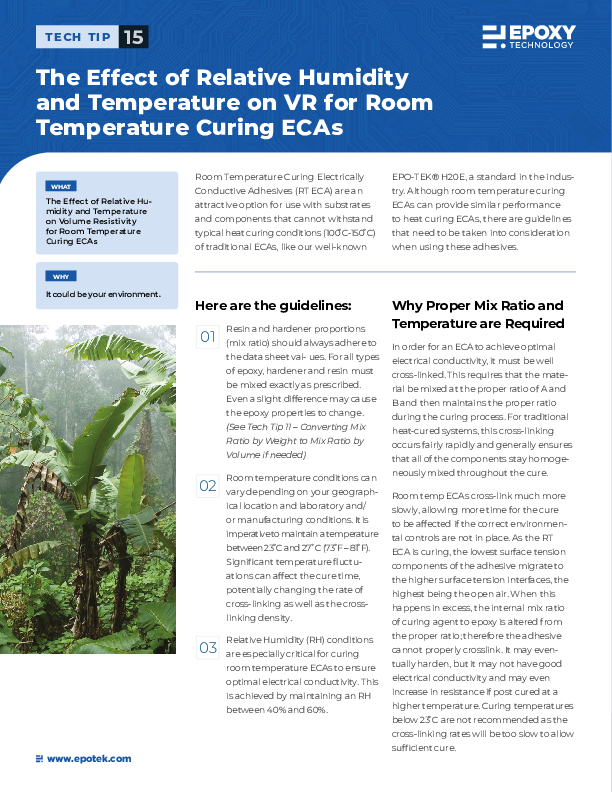
Room Temp Curing ECAs What: The Effect of Relative Humidity and Temperature on Volume Resistivity for Room Temperature Curing ECAs Why: It could be your environment.
Also available in: GermanTech Tip 25 Dielectric Properties of Epoxies
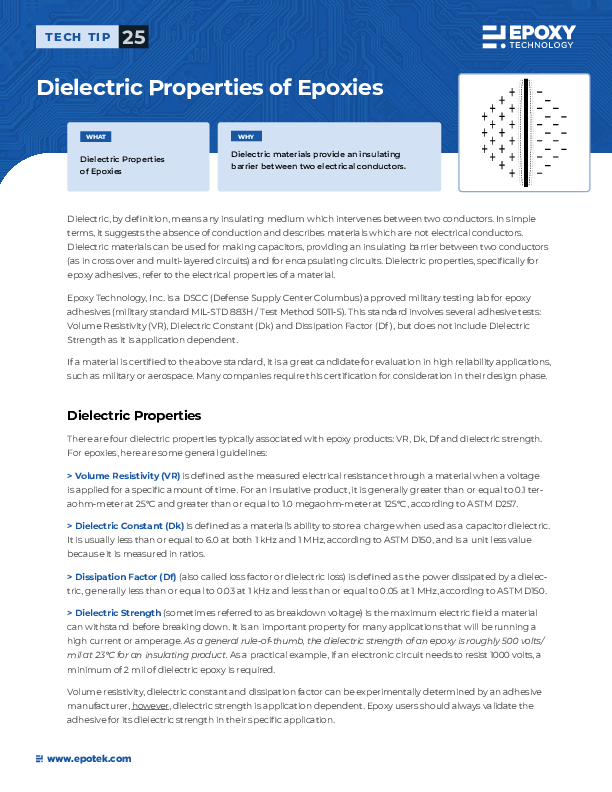
Tech Tip 25 - Dielectric Properties of Epoxies What: Dielectric Properties of Epoxies Why: Dielectric materials provide an insulating barrier between two electrical conductors.
Also available in: GermanTech Tip 16 Understanding and Preventing Epoxy Resin Bleed
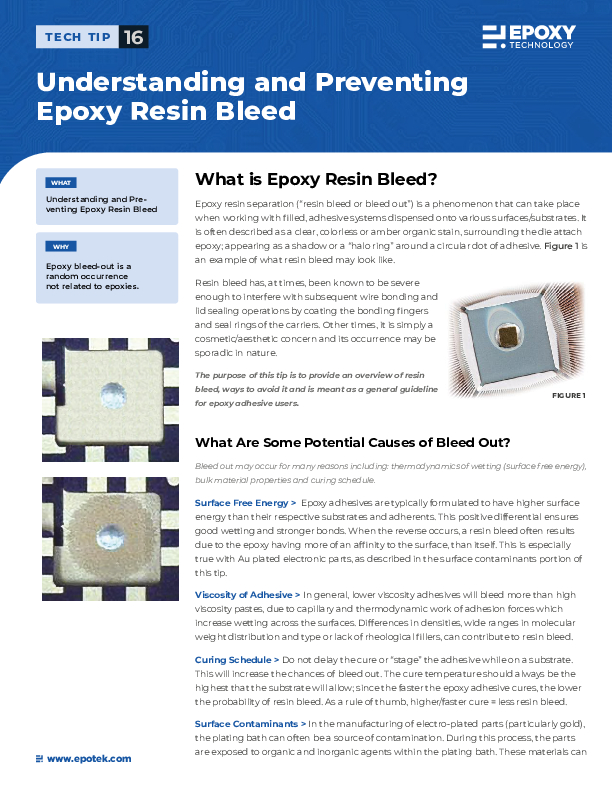
Tech Tip 16 - Understanding & Preventing Epoxy Resin Bleed What: Understanding and Preventing Epoxy Resin Bleed Why: Epoxy bleed-out is a random occurrence not related to epoxies.
Also available in: GermanTech Tip 28 Amine Blush
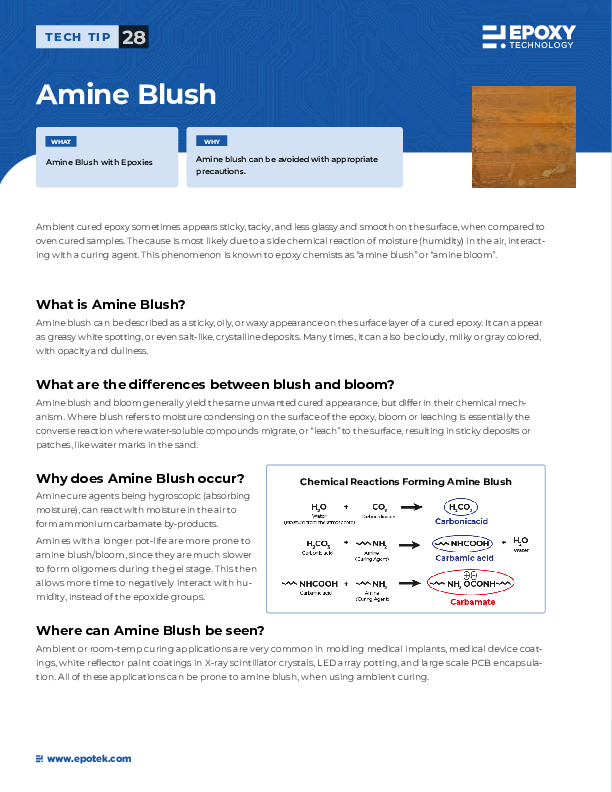
Tech Tip 28 - Amine Blush What: Amine Blush with Epoxies Why: Amine blush canbe avoided with appropriateprecautions.
Also available in: GermanTech Tip 17 Identifying Particles in an Epoxy Adhesive Using Hegman Gauge (Grind Gauge) Analysis
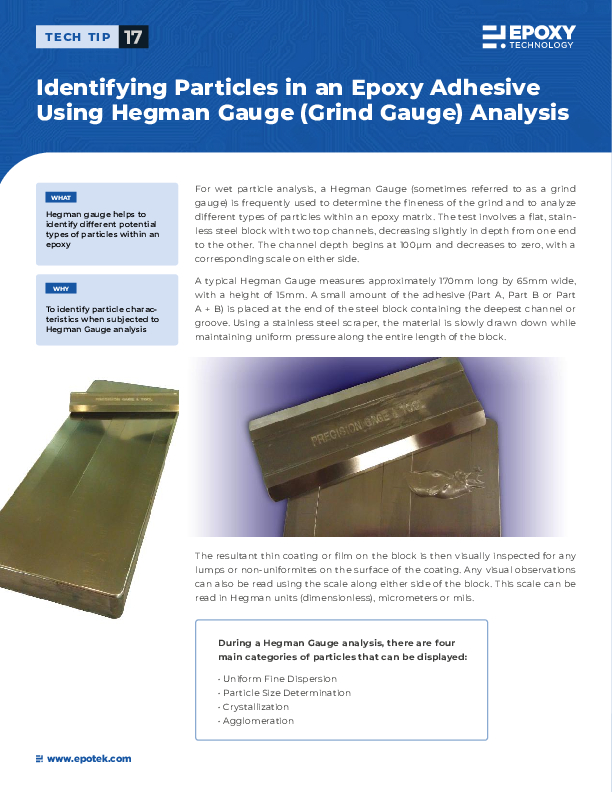
Identifying Particles in an Epoxy Adhesive Using Hegman Gauge Analysis What: Hegman gauge helps to identify different potential types of particles within an epoxy Why: To identify particle characteristics when subjected to Hegman Gauge analysis
Also available in: GermanTech Tip 24 Bonding to Aluminum
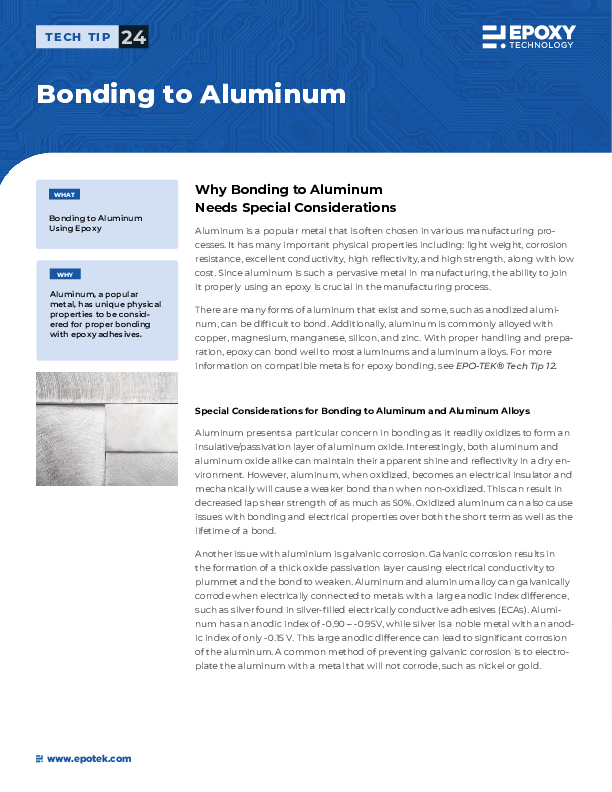
Tech Tip 24 - Bonding to Aluminum What: Bonding to Aluminum Using Epoxy Why: Aluminum, a popular metal has unique physical properties that need to be taken into consideration for proper bonding with epoxy adhesives.
Also available in: GermanTech Tip 18 Understanding Optical Properties of Epoxy Applications
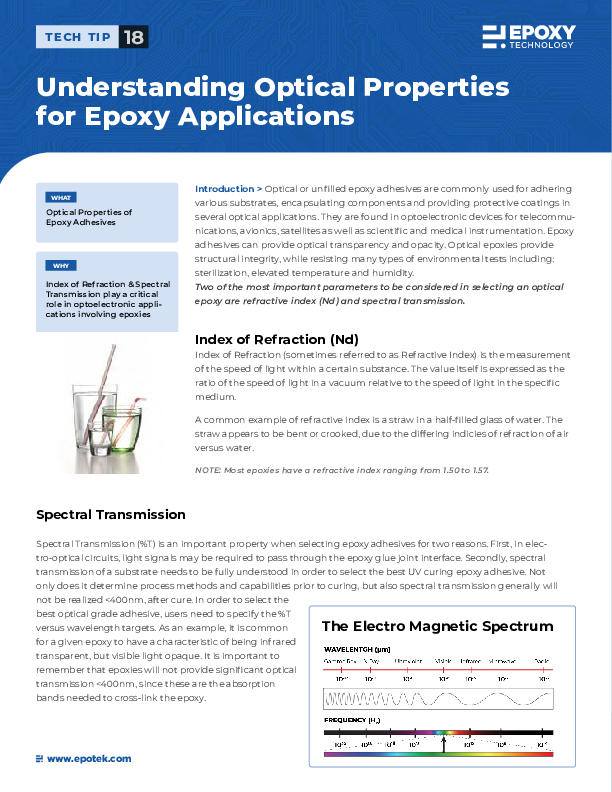
Tech Tip 18 - Understanding Optical Properties for Epoxy Applications What: Optical Properties of Epoxy Adhesives Why: Index of Refraction & Spectral Transmission play a critical role in optoelectronic applications involving epoxies
Also available in: GermanTech Tip 22 Using Mold Release Agents with Epoxy Adhesives
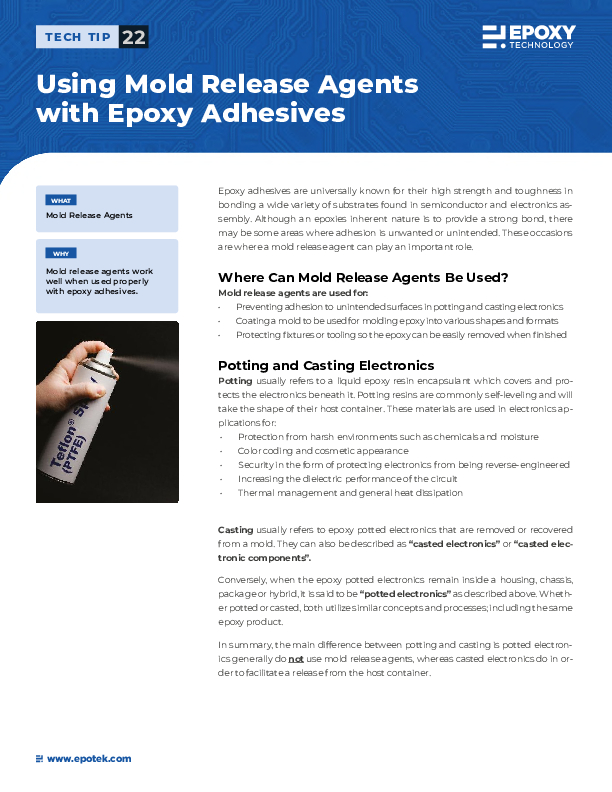
Tech Tip 22 - Using Mold Release Agents with Epoxy Adhesives What: Mold Release Agents Why: Mold release agents work well when used properly with epoxy adhesives.
Also available in: GermanTech Tip 26 Pot Life, Working Life and Gel Time of Epoxies
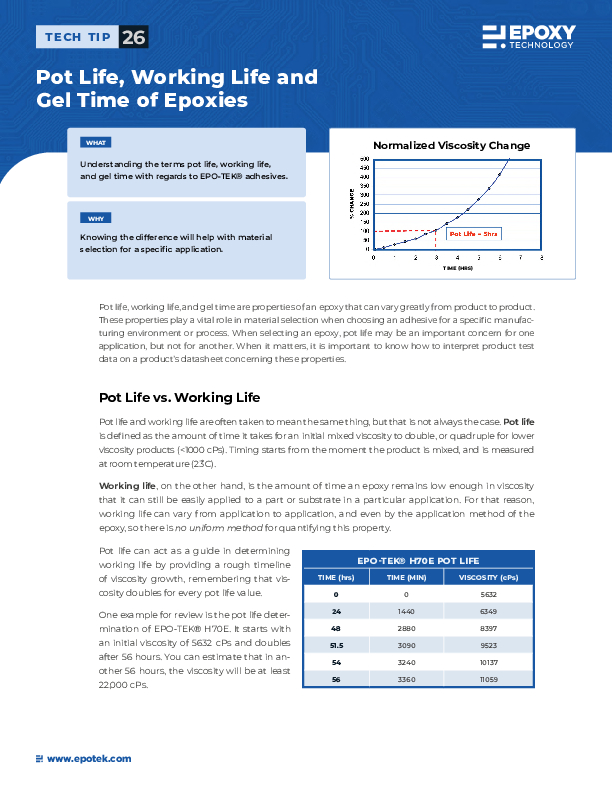
Tech Tip 26 - Pot Life, Working Life and Gel Time of Epoxies What: Understanding the terms pot life, working life and gel time with regards to EPO-TEK® adhesives. Why: Knowing the difference will help with material selection for a specific application.
Also available in: GermanTech Tip 9 UV Cure Adhesives-Tips, Tricks & Troubleshooting
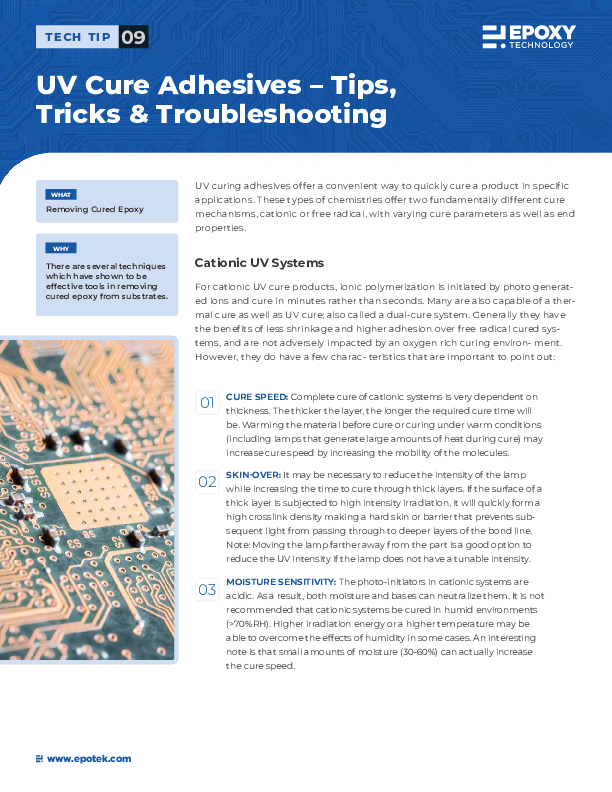
Tech Tip 9 - UV Cure Adhesives What: UV Curing Tips Why: UV curing adhesives offer a convenient way to quickly cure a product in specific applications.
Also available in: German FrenchWhat's New R&D - Room Temperature Curing Optical Adhesives
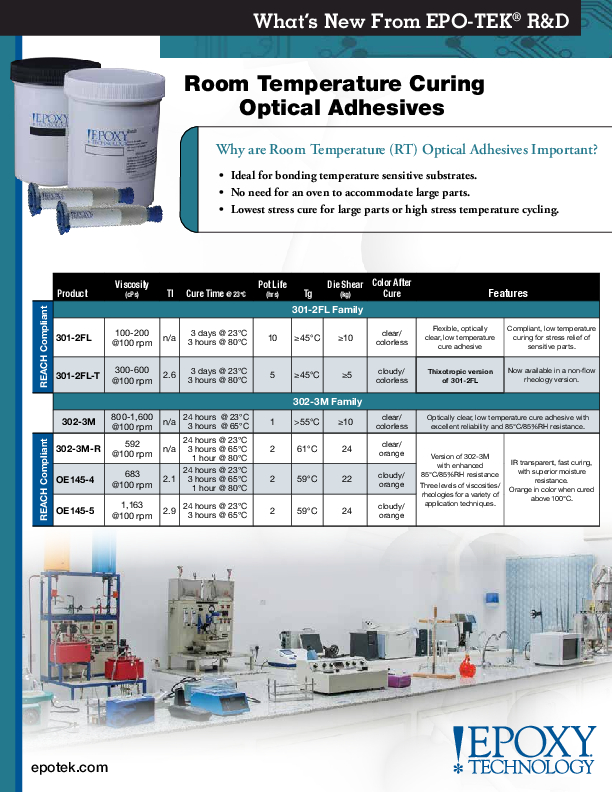
Room Temperature Curing Optical Adhesives 0-3175 Epoxy Technology presents Room Temperature Curing Electrically Conductive Optical Adhesives. These materials are ideal for temperature sensitive substrates, no need for an oven to accommodate large parts, and the lowest stress cure for large parts or high stress temperature cycling.
Tech Tip 29 Gamma Sterilization for Medical Devices and its Effect on Epoxies
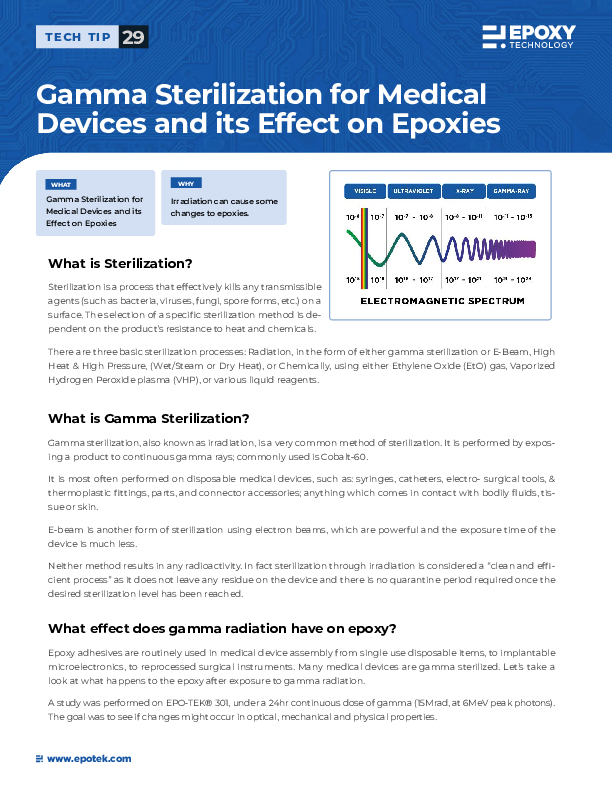
Tech Tip 29 - Gamma Sterilization for Medical Devices and its Effect on Epoxies What: Gamma Sterilization for Medical Devices and its Effect on Epoxies Why: Irradiation can cause some changes to epoxies.
Also available in: GermanTech Tip 3 Viscosity and Thixotropic Index
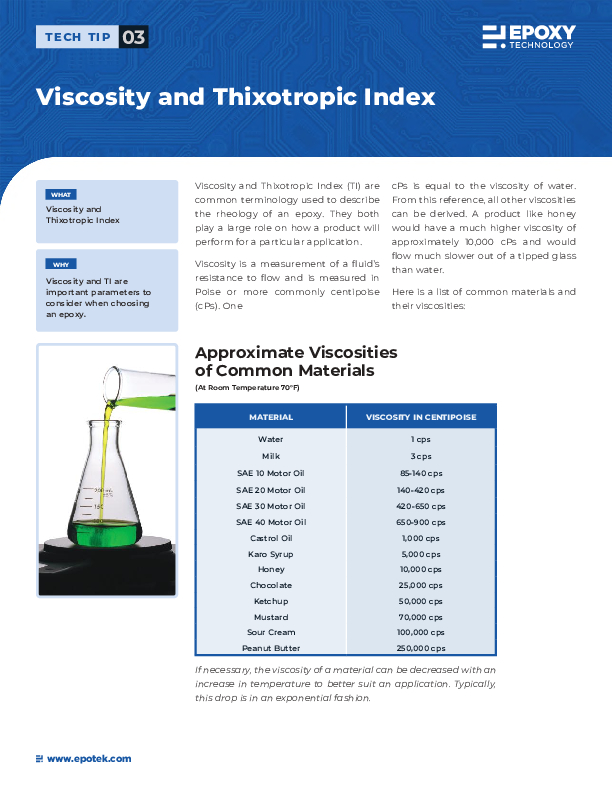
Viscosity and TI What: Viscosity and Thixotropic Index Why: Viscosity and TI are important parameters to consider when choosing an epoxy.
Also available in: German FrenchTech Tip 8 Reworking, Removing, and “Decapsulating” Cured Epoxies
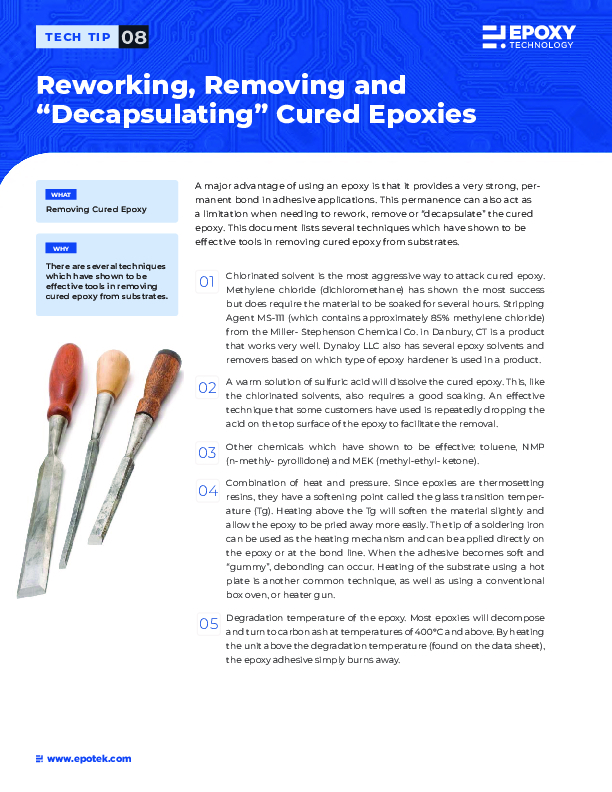
Reworking Cured Epoxy What: Removing Cured Epoxy Why: There are several techniques which have shown to be effective tools in removing cured epoxy from substrates.
Also available in: GermanTech Tip 30 Understanding How to Choose an Appropriate Thermally Conductive Epoxy
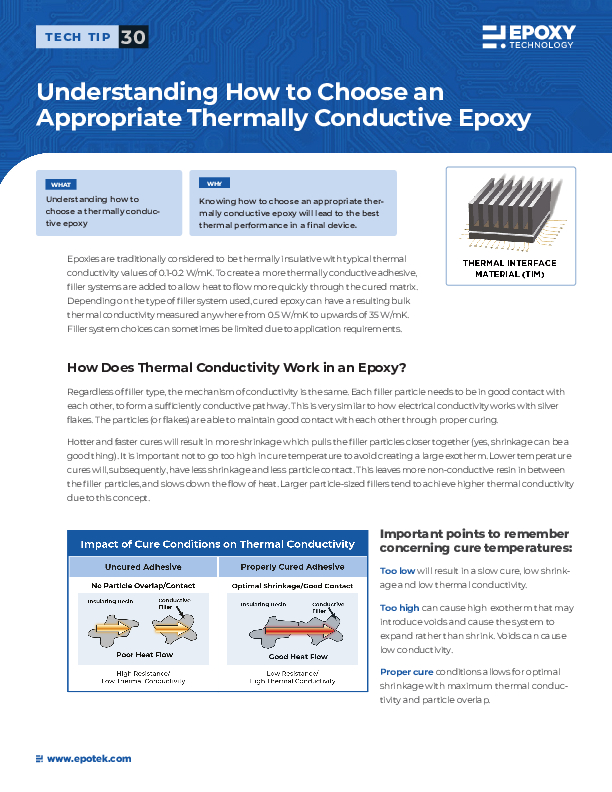
Understanding How to Choose an Appropriate Thermally Conductive Epoxy What: Understanding how to choose a thermally conductive epoxy Why: Knowing how to choose an appropriate thermally conductive epoxy will lead to the best thermal performance in a final device.
Also available in: GermanTech Tip 31 Understanding Biocompatibility of Epoxy Adhesives Versus Curing Schedule
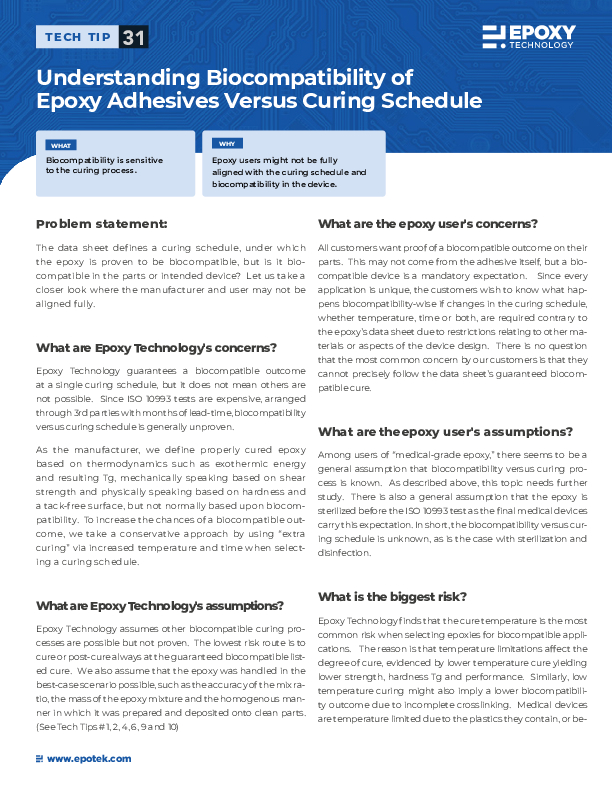
Tech Tip 31 – Understanding Biocompatibility of Epoxy Adhesives Versus Curing Schedule What: Biocompatibility is sensitive to the curing process. Why: Epoxy users might not be fully aligned with the curing schedule and biocompatibility in the device.-143510-26202600
Tech Tip 4 Removing Bubbles from Epoxy
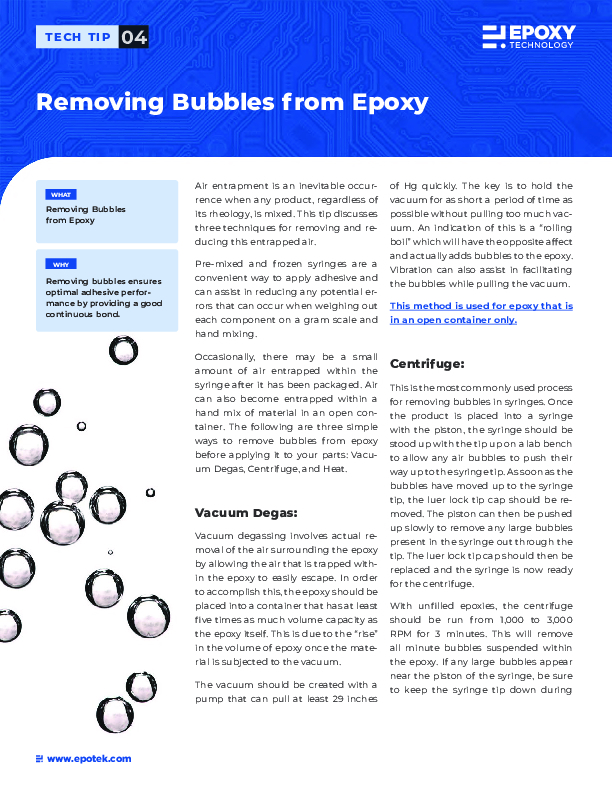
Removing Bubbles What: Removing Bubbles from Epoxy Why: Removing bubbles ensures optimal adhesive performance by providing a good continuous bond.
Also available in: German FrenchWhat’s New from EPO-TEK® R&D- Flexible Electrically Conductive Adhesives
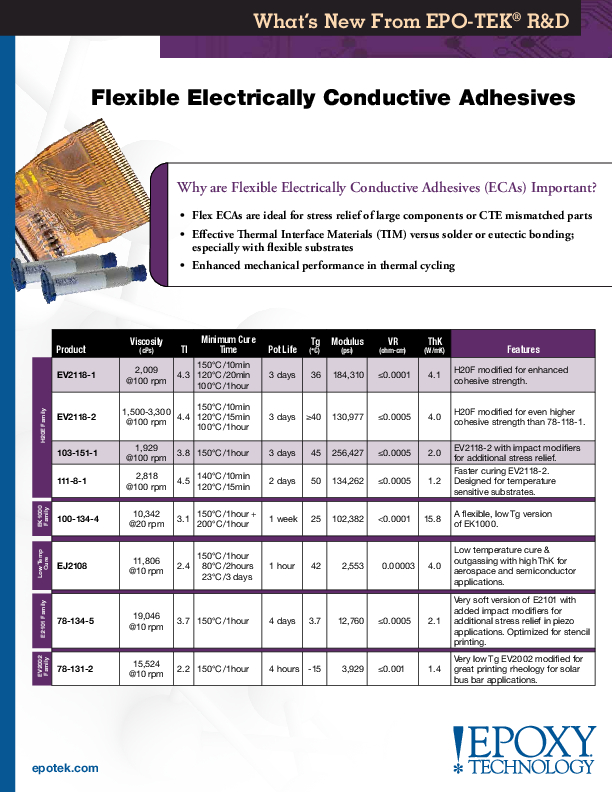
Flexible Electrically Conductive Adhesives Epoxy Technology presents New Flexible Electrically Conductive Adhesives. These materials are ideal for stress relief for large components or CTE mismatch parts. They also can enhance mechanical performance in thermal cycling.
Tech Tip 5 Using an EPO-TEK® Product After the Shelf Life has Expired
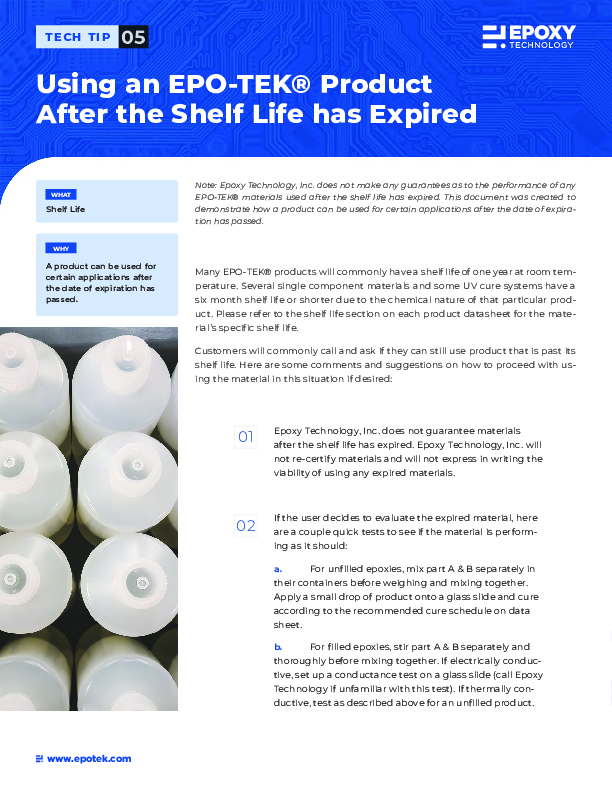
Tech Tip 5 - Using Expired Product What: Shelf Life Why: A product can be used for certain applications after the date of expiration has passed.
Also available in: GermanTech Tip 6 Minimum Bond Line (Cure and Thickness)
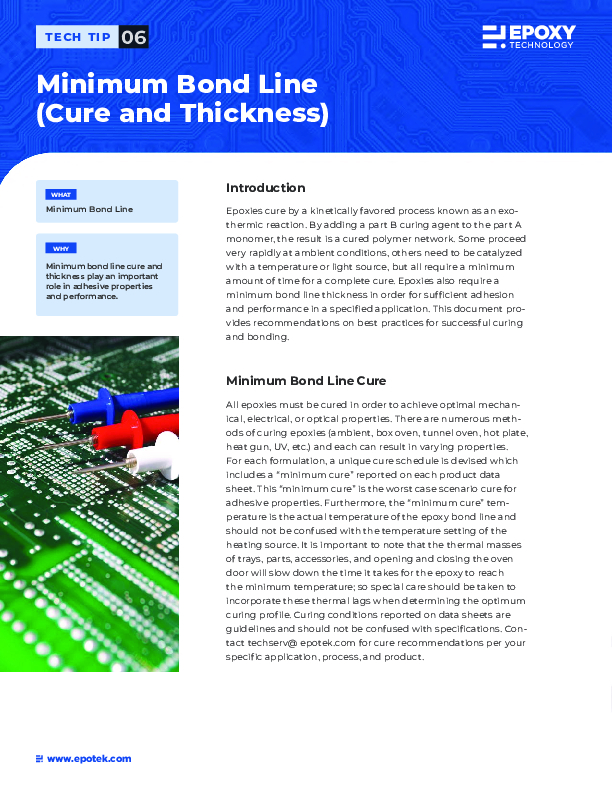
Tech Tip 6 - Minimum Bond Line What: Minimum Bond Line Why: Minimum bond line cure and thickness play an important role in adhesive properties and performance.
Also available in: GermanTech Tip 7 Epoxy Crystallization
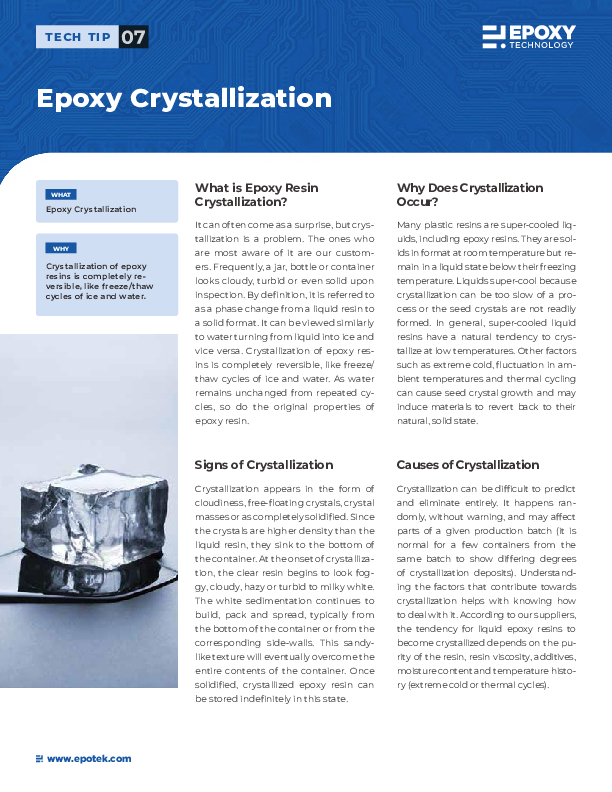
Tech Tip 7 - Epoxy Crystallization What: Epoxy Crystallization Why: Crystallization of epoxy resins is completely reversible, like freeze/thaw cycles of ice and water.
Also available in: German FrenchWhat’s New from EPO-TEK® R&D- Halogen Free Epoxy Adhesives
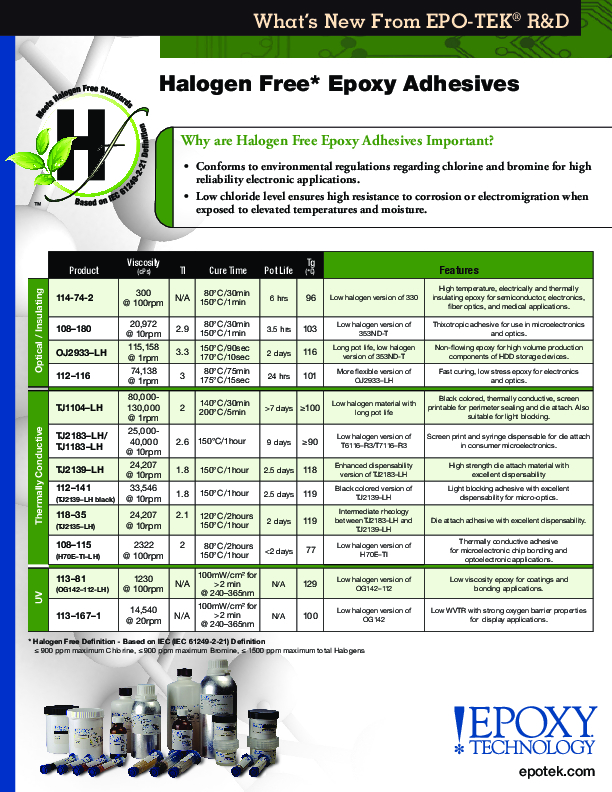
Halogen Free* Epoxy Adhesives Epoxy Technology offers New Halogen Free* Epoxy Adhesives. These products conform to environmental regulations and provide corrosion or electromigration resistance for high reliability electronic applications.
What’s New from EPO-TEK® R&D- Electrically Conductive Adhesives with Enhanced Dispense Properties
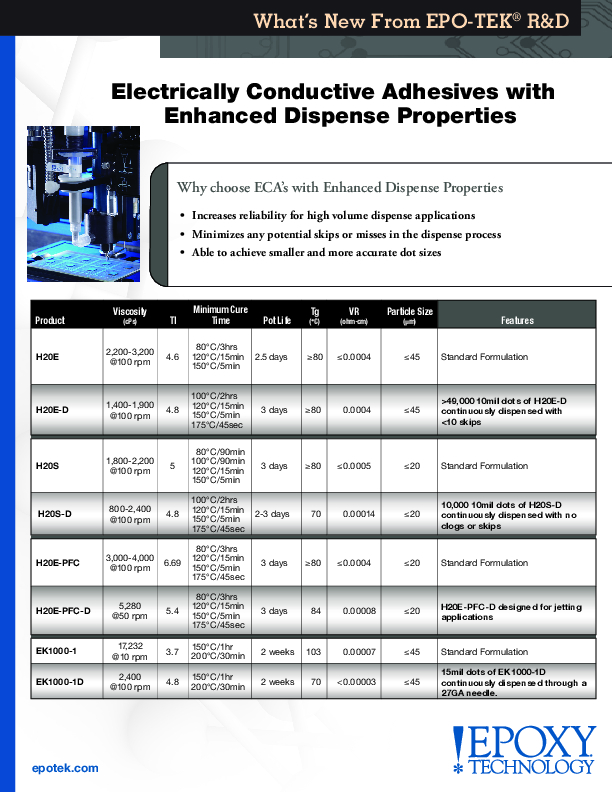
Electrically Conductive Adhesives with Enhanced Dispense Properties Epoxy Technology offers Electrically Conductive Adhesives with Enhanced Dispensed Properties. These materials increase the reliability of high volume dispense applications by minimizing the potential for skips or misses in the dispense process, while allowing for smaller and more accurate dot sizes.
What’s New from EPO-TEK® R&D- Fast Curing Electrically Conductive Adhesives (ECAs)
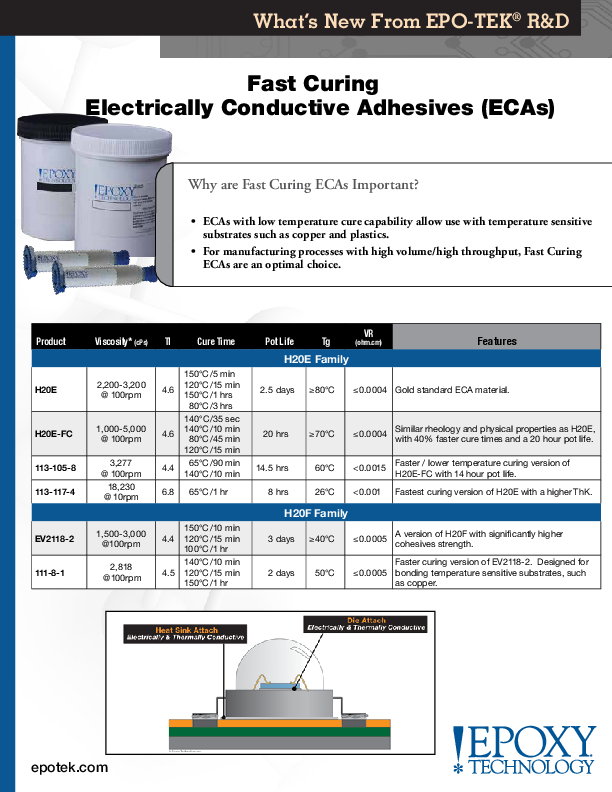
Fast Curing Electrically Conductive Adhesives (ECAs) Epoxy Technology, Inc. (EPO-TEK®) offers an expanded line of Fast Curing Electrically Conductive Adhesives (ECAs). These ECAs are ideal for low temperature cure capability allowing use with temperature sensitive substrates such as copper and plastics. Fast Curing ECAs are an optimal choice for manufacturing processes with high volume/high throughput.
What’s New from EPO-TEK® R&D- Room Temperature Curing Electrically Conductive Adhesives
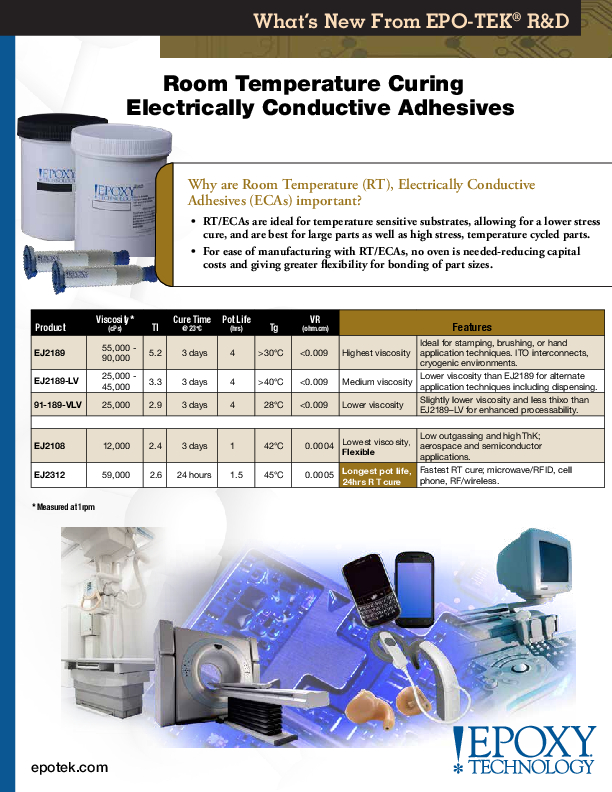
Room Temperature Curing ECAs 00 Epoxy Technology, Inc. (EPO-TEK®) offers an expanded line of Room Temperature Curing Electrically Conductive Adhesives (ECAs). These ECAs are ideal for temperature sensitive substrates, allowing for a lower stress cure, best for large parts as well as high stress, temperature cycled parts. These epoxies require no oven curing; reducing capital costs and giving greater flexibility for bonding various part sizes. EPO-TEK® EJ2189, EJ2189-LV, EJ2108, and EJ2312 are excellent options for applications that require a Room Temperature ECA.
Product Information SHEETS
- E2082 · TDS · SDS
- 301-1 · TDS · SDS
- E2101 · TDS · SDS · Syringe
- E3001-HV · TDS · SDS
- 301-2 · TDS · SDS · Syringe
- 509EBT-M1 · TDS · SDS
- 301-2FL-CX · TDS · SDS · Syringe
- 730 Black · TDS · SDS
- 301-2FL-G · TDS · SDS
- 730-110 Black · TDS · SDS
- 301-2FL-LY · TDS · SDS · Syringe
- 730-110 · TDS · SDS
- 301-2FL-MR · TDS
- 730 · TDS · SDS · Syringe
- 301-2FL-T · TDS · SDS · Syringe
- E4110-LV · TDS · SDS
- 301-2FL · TDS · SDS · Syringe
- E4110-PFC · TDS · SDS · Syringe
- 301-2G · TDS · SDS · Syringe
- E4110 · TDS · SDS · Syringe
- 301 · TDS · SDS · Syringe
- 920-FL · TDS · SDS
- 302-3M Black · TDS · SDS
- EE112-1 · TDS · SDS
- 302-3M-R · TDS · SDS · Syringe
- EE149-6 · TDS · SDS
- 302-3M · TDS · SDS · Syringe
- EE165-3 · TDS · SDS
- 302 · TDS · SDS
- EE178-9 · TDS · SDS
- 305 · TDS · SDS
- 731 · TDS · SDS
- 310M BLACK · TDS
- EH100 · TDS · SDS
- 310M-1 · TDS · SDS · Syringe
- EJ2108 · TDS · SDS · Syringe
- 310M-2 · TDS · SDS · Syringe
- EJ2189-LV · TDS · SDS · Syringe
- 310M · TDS · SDS · Syringe
- EJ2189 · TDS · SDS · Syringe
- 310T-M · TDS · SDS
- EJ2312 · TDS · SDS · Syringe
- 314 · TDS · SDS · Syringe
- EK1000-1-D · TDS · SDS
- 320-3 · TDS · SDS
- EK1000-1 · TDS · SDS
- 320-LV · TDS · SDS
- EK1000-1MP · TDS · SDS
- 320 · TDS · SDS · Syringe
- EK1000-MP · TDS · SDS
- 320NC-2 · TDS · SDS
- EK1000 · TDS · SDS
- 320NC · TDS · SDS
- 920 · TDS · SDS
- 323LP-LH Premium · TDS · SDS · Syringe
- 921-FL · TDS · SDS
- 323LP-LH Ultra · TDS
- EK2000 · TDS · SDS
- 323LP-T · TDS · SDS · Syringe
- EM127 · TDS · SDS
- 323LP · TDS · SDS · Syringe
- EV2118-1 · TDS · SDS
- 330-LH · TDS · SDS · Syringe
- EV2118-2 · TDS · SDS · Syringe
- 330 · TDS · SDS · Syringe
- GD2191 · TDS · SDS
- 343ND-LH · TDS · SDS · Syringe
- 921 · TDS · SDS
- 353ND Black · TDS · Syringe
- B9144 · TDS · SDS
- 353ND-LH Ultra · TDS · SDS · Syringe
- B9126-8 · TDS · SDS
- 353ND-T BLACK · TDS · SDS
- GE116-1 · TDS · SDS
- 353ND-T · TDS · SDS · Syringe
- GE116 · TDS · SDS
- 353ND-T1 · TDS · SDS · Syringe
- GE120 · TDS · SDS
- 353ND-T3 · TDS · SDS
- GL2154 · TDS
- 353ND-T4 · TDS · SDS · Syringe
- H20E-175 · TDS · SDS · Syringe
- 353ND-T5 · TDS · SDS
- H20E-8 · TDS · SDS · Syringe
- 353ND · TDS · SDS · Syringe
- H20E-D · TDS · SDS
- 360 · TDS · SDS · Syringe
- H20E-FC · TDS · SDS · Syringe
- 360ST · TDS · SDS
- H20E-HC · TDS · SDS · Syringe
- 360T · TDS · SDS · Syringe
- H20E-LC · TDS · SDS
- 375-T · TDS · SDS · Syringe
- 375 · TDS · SDS · Syringe
- H20E-MP · TDS · SDS · Syringe
- 377 · TDS · SDS · Syringe
- H20E-PFC-D · TDS · SDS
- 377H · TDS · SDS · Syringe
- E2001-6 · TDS · SDS
- 383ND-LH Premium · TDS · SDS
- H70E-2 Unpigmented · TDS
- 383ND-LH Ultra · TDS · SDS
- E2001-HV · TDS · SDS
- 383ND-T-D · TDS · SDS · Syringe
- H20E-PFC-T · TDS · SDS · Syringe
- 383ND · TDS · SDS · Syringe
- H20E-PFC · TDS · SDS · Syringe
- 390 · TDS · SDS
- H20E-SLR-HV · TDS · SDS
- 430 · TDS · SDS
- H20E-SLR-HVMX · TDS · SDS
- 431 · TDS · SDS
- 930-1 · TDS · SDS
- H20E-SLR-MX · TDS · SDS
- 930-4 · TDS · SDS · Syringe
- H20E-SLR · TDS · SDS
- 930 · TDS · SDS
- H20E · TDS · SDS · Syringe
- AP-100 · TDS · SDS
- H20F · TDS · SDS · Syringe
- B1118-LH · TDS · SDS
- H20S-D · TDS · SDS
- B13181 · TDS · SDS
- H20S · TDS · SDS · Syringe
- B9021-14 · TDS · SDS
- H21D · TDS · SDS · Syringe
- B9021 · TDS · SDS
- E2036 · TDS · SDS · Syringe
- B9101-2 Unfilled · TDS
- H22 · TDS · SDS · Syringe
- B9126-7 · TDS · SDS
- H24 · TDS · SDS · Syringe
- H27D · TDS · SDS · Syringe
- H31 · TDS · SDS
- H31D · TDS · SDS
- H31LV · TDS
- H35-175MP · TDS · SDS · Syringe
- H35-175MPLV · TDS · SDS
- H35-175MPT · TDS · SDS
- H37-MP · TDS · SDS · Syringe
- H37-MPT · TDS · SDS
- H37MP-2 · TDS · SDS
- H44 · TDS · SDS
- H54 · TDS · SDS · Syringe
- H61-110 · TDS · SDS
- H61 · TDS · SDS · Syringe
- H61LV · TDS · SDS
- H61ND · TDS · SDS
- H62 · TDS · SDS
- H65-175MP · TDS · SDS · Syringe
- H67-MP · TDS · SDS
- H67MP-T · TDS · SDS
- H70E-1 · TDS · SDS
- H70E-175 · TDS · SDS · Syringe
- OG133-7 · TDS · SDS
- H70E-2 · TDS · SDS · Syringe
- OG133-8 · TDS · SDS
- H70E-2LC · TDS · SDS
- OG142-112-LH · TDS
- H70E-4 · TDS · SDS · Syringe
- OD1001 · TDS · SDS
- H70E-TI-LH · TDS · SDS · Syringe
- OG142-112 · TDS · SDS
- H70E-TI · TDS · SDS
- OG142-6 · TDS · SDS
- H70E · TDS · SDS · Syringe
- OG142-87 · TDS · SDS · Syringe
- H70S · TDS · SDS · Syringe
- OG142 · TDS · SDS · Syringe
- H72 · TDS · SDS · Syringe
- OG154-1 · TDS · SDS
- H73 · TDS · SDS · Syringe
- OG159-2 · TDS · SDS
- H74-110 · TDS · SDS · Syringe
- OG198-54 · TDS · SDS · Syringe
- H74 · TDS · SDS · Syringe
- OG198-55-1 · TDS · SDS
- H74F · TDS · SDS · Syringe
- OG198-55 · TDS · SDS · Syringe
- H74G · TDS · SDS
- OG198-55HV · TDS · SDS
- H75 · TDS · SDS
- OD1001-67 WHITE · TDS · SDS
- H77 Black · TDS · SDS
- OG198-763 · TDS · SDS
- H77 · TDS · SDS · Syringe
- OG603 · TDS
- H77S · TDS · SDS · Syringe
- OG675 · TDS · SDS
- H77T · TDS · SDS · Syringe
- OH105-2 · TDS · SDS · Syringe
- H81 · TDS · SDS
- OH105 · TDS · SDS
- H81A · TDS · SDS
- OD121-42 Rev II · TDS
- HYB-297-RT-HV · TDS · SDS
- OD121-42 · TDS · Syringe
- HYB-297-RT · TDS · SDS
- OD1361 · TDS · SDS
- HYB-353ND-HV · TDS · SDS · Syringe
- OD1551 · TDS · SDS
- HYB-353ND-LV · TDS · SDS · Syringe
- OD1607 · TDS · SDS
- HYB-353ND-TX2 · TDS · SDS · Syringe
- OD2002 · TDS · SDS · Syringe
- HYB-353ND-TX3 · TDS · SDS
- OE100-T · TDS · SDS · Syringe
- HYB-353ND · TDS · SDS
- OH108-1 · TDS · SDS
- M10-D · TDS · SDS
- OJ2116 · TDS · SDS
- MA-5 · TDS
- OE101 · TDS · SDS
- MED-301-2 · TDS · SDS · Syringe
- OE107M · TDS · SDS
- MED-301-2FL · TDS · SDS · Syringe
- OJ2145-1 · TDS · SDS
- OE121 Black · TDS · SDS
- MED-302-3M Black · TDS · SDS
- OE121 · TDS · SDS · Syringe
- MED-302-3M-R · TDS · SDS
- OE138 · TDS · SDS · Syringe
- MED-302-3M · TDS · SDS
- OJ2145 · TDS · SDS · Syringe
- MED-320 · TDS · SDS · Syringe
- OE145-4 · TDS · SDS
- MED-323LP · TDS · SDS · Syringe
- OE145-5 · TDS · SDS
- MED-353ND BLACK · TDS · SDS
- OE145-6 · TDS · SDS
- MED-353ND-T · TDS · SDS · Syringe
- OE145-7 · TDS · SDS
- MED-353ND · TDS · SDS · Syringe
- OJ2933-LH · TDS · SDS · Syringe
- MED-375 · TDS · SDS · Syringe
- OM100 · TDS
- MED-377 · TDS · SDS
- OE175-2 · TDS · SDS
- MED-730-110 · TDS · SDS
- OM118 · TDS · SDS
- MED-H20E · TDS · SDS · Syringe
- OM125 · TDS · SDS
- MED-H20S · TDS · SDS · Syringe
- OE184 · TDS · SDS
- MED-HYB-353ND · TDS · Syringe
- OE188-3 · TDS · SDS
- MED-OD2002 · TDS · SDS · Syringe
- OE188 · TDS · SDS · Syringe
- MED-OG116-31 · TDS · SDS
- OG114-4 · TDS · SDS
- MED-OG198-54 · TDS · SDS · Syringe
- MED-301 · TDS · SDS · Syringe
- MED-OG198-55 · TDS · SDS · Syringe
- OG116-31 · TDS · SDS
- MED-T7110 · TDS · SDS
- OG116 · TDS · SDS
- MED-XXX-TDS · TDS
- OP2126 · TDS · SDS
- N20E · TDS · SDS
- OP2131 · TDS · SDS
- O205NC · TDS · SDS
- OV2172 · TDS · SDS
- P10 · TDS · SDS
- PI Thinner · TDS · SDS
- T-7 · TDS
- T6065-LV · TDS · SDS
- T6067-3 · TDS · SDS · Syringe
- T6067 · TDS · SDS
- T6116-1 · TDS
- T6116-R3 · TDS · SDS
- T7109-17 · TDS · SDS · Syringe
- T7109-18 · TDS · SDS · Syringe
- T7109-19 · TDS · SDS · Syringe
- T7109-20 · TDS · SDS
- T7109 · TDS · SDS · Syringe
- T7110-38 · TDS · SDS
- T7110 · TDS · SDS · Syringe
- T7116-R3 · TDS
- T7139 · TDS · SDS · Syringe
- T905-1 Black · TDS · SDS
- T905-1 · TDS · SDS · Syringe
- T905BN-3 · TDS · SDS
- T905BN-4 · TDS · SDS
- TD1001-67 · TDS · SDS
- TD1001 · TDS · SDS
- TE109-15 · TDS · SDS
- TH106-5 · TDS · SDS
- TH106-6 · TDS · SDS
- TJ2139-LH Black · TDS · SDS · Syringe
- TJ2139-LH · TDS · SDS · Syringe
- TM121 · TDS · SDS
- TR2139-LH · TDS · SDS · Syringe
- TV2001 · TDS · SDS · Syringe
- TZ101 · TDS · SDS
- UD1214 · TDS · SDS
- UD1355 · TDS · SDS
- UD1824 · TDS · SDS
- UD1927 · TDS · SDS
- UJ1190 · TDS · SDS
Datasheets
- E2082 · TDS · SDS
- 301-1 · TDS · SDS
- E2101 · TDS · SDS · Syringe
- E3001-HV · TDS · SDS
- 301-2 · TDS · SDS · Syringe
- 509EBT-M1 · TDS · SDS
- 301-2FL-CX · TDS · SDS · Syringe
- 730 Black · TDS · SDS
- 301-2FL-G · TDS · SDS
- 730-110 Black · TDS · SDS
- 301-2FL-LY · TDS · SDS · Syringe
- 730-110 · TDS · SDS
- 301-2FL-MR · TDS
- 730 · TDS · SDS · Syringe
- 301-2FL-T · TDS · SDS · Syringe
- E4110-LV · TDS · SDS
- 301-2FL · TDS · SDS · Syringe
- E4110-PFC · TDS · SDS · Syringe
- 301-2G · TDS · SDS · Syringe
- E4110 · TDS · SDS · Syringe
- 301 · TDS · SDS · Syringe
- 920-FL · TDS · SDS
- 302-3M Black · TDS · SDS
- EE112-1 · TDS · SDS
- 302-3M-R · TDS · SDS · Syringe
- EE149-6 · TDS · SDS
- 302-3M · TDS · SDS · Syringe
- EE165-3 · TDS · SDS
- 302 · TDS · SDS
- EE178-9 · TDS · SDS
- 305 · TDS · SDS
- 731 · TDS · SDS
- 310M BLACK · TDS
- EH100 · TDS · SDS
- 310M-1 · TDS · SDS · Syringe
- EJ2108 · TDS · SDS · Syringe
- 310M-2 · TDS · SDS · Syringe
- EJ2189-LV · TDS · SDS · Syringe
- 310M · TDS · SDS · Syringe
- EJ2189 · TDS · SDS · Syringe
- 310T-M · TDS · SDS
- EJ2312 · TDS · SDS · Syringe
- 314 · TDS · SDS · Syringe
- EK1000-1-D · TDS · SDS
- 320-3 · TDS · SDS
- EK1000-1 · TDS · SDS
- 320-LV · TDS · SDS
- EK1000-1MP · TDS · SDS
- 320 · TDS · SDS · Syringe
- EK1000-MP · TDS · SDS
- 320NC-2 · TDS · SDS
- EK1000 · TDS · SDS
- 320NC · TDS · SDS
- 920 · TDS · SDS
- 323LP-LH Premium · TDS · SDS · Syringe
- 921-FL · TDS · SDS
- 323LP-LH Ultra · TDS
- EK2000 · TDS · SDS
- 323LP-T · TDS · SDS · Syringe
- EM127 · TDS · SDS
- 323LP · TDS · SDS · Syringe
- EV2118-1 · TDS · SDS
- 330-LH · TDS · SDS · Syringe
- EV2118-2 · TDS · SDS · Syringe
- 330 · TDS · SDS · Syringe
- GD2191 · TDS · SDS
- 343ND-LH · TDS · SDS · Syringe
- 921 · TDS · SDS
- 353ND Black · TDS · Syringe
- B9144 · TDS · SDS
- 353ND-LH Ultra · TDS · SDS · Syringe
- B9126-8 · TDS · SDS
- 353ND-T BLACK · TDS · SDS
- GE116-1 · TDS · SDS
- 353ND-T · TDS · SDS · Syringe
- GE116 · TDS · SDS
- 353ND-T1 · TDS · SDS · Syringe
- GE120 · TDS · SDS
- 353ND-T3 · TDS · SDS
- GL2154 · TDS
- 353ND-T4 · TDS · SDS · Syringe
- H20E-175 · TDS · SDS · Syringe
- 353ND-T5 · TDS · SDS
- H20E-8 · TDS · SDS · Syringe
- 353ND · TDS · SDS · Syringe
- H20E-D · TDS · SDS
- 360 · TDS · SDS · Syringe
- H20E-FC · TDS · SDS · Syringe
- 360ST · TDS · SDS
- H20E-HC · TDS · SDS · Syringe
- 360T · TDS · SDS · Syringe
- H20E-LC · TDS · SDS
- 375-T · TDS · SDS · Syringe
- 375 · TDS · SDS · Syringe
- H20E-MP · TDS · SDS · Syringe
- 377 · TDS · SDS · Syringe
- H20E-PFC-D · TDS · SDS
- 377H · TDS · SDS · Syringe
- E2001-6 · TDS · SDS
- 383ND-LH Premium · TDS · SDS
- H70E-2 Unpigmented · TDS
- 383ND-LH Ultra · TDS · SDS
- E2001-HV · TDS · SDS
- 383ND-T-D · TDS · SDS · Syringe
- H20E-PFC-T · TDS · SDS · Syringe
- 383ND · TDS · SDS · Syringe
- H20E-PFC · TDS · SDS · Syringe
- 390 · TDS · SDS
- H20E-SLR-HV · TDS · SDS
- 430 · TDS · SDS
- H20E-SLR-HVMX · TDS · SDS
- 431 · TDS · SDS
- 930-1 · TDS · SDS
- H20E-SLR-MX · TDS · SDS
- 930-4 · TDS · SDS · Syringe
- H20E-SLR · TDS · SDS
- 930 · TDS · SDS
- H20E · TDS · SDS · Syringe
- AP-100 · TDS · SDS
- H20F · TDS · SDS · Syringe
- B1118-LH · TDS · SDS
- H20S-D · TDS · SDS
- B13181 · TDS · SDS
- H20S · TDS · SDS · Syringe
- B9021-14 · TDS · SDS
- H21D · TDS · SDS · Syringe
- B9021 · TDS · SDS
- E2036 · TDS · SDS · Syringe
- B9101-2 Unfilled · TDS
- H22 · TDS · SDS · Syringe
- B9126-7 · TDS · SDS
- H24 · TDS · SDS · Syringe
- H27D · TDS · SDS · Syringe
- H31 · TDS · SDS
- H31D · TDS · SDS
- H31LV · TDS
- H35-175MP · TDS · SDS · Syringe
- H35-175MPLV · TDS · SDS
- H35-175MPT · TDS · SDS
- H37-MP · TDS · SDS · Syringe
- H37-MPT · TDS · SDS
- H37MP-2 · TDS · SDS
- H44 · TDS · SDS
- H54 · TDS · SDS · Syringe
- H61-110 · TDS · SDS
- H61 · TDS · SDS · Syringe
- H61LV · TDS · SDS
- H61ND · TDS · SDS
- H62 · TDS · SDS
- H65-175MP · TDS · SDS · Syringe
- H67-MP · TDS · SDS
- H67MP-T · TDS · SDS
- H70E-1 · TDS · SDS
- H70E-175 · TDS · SDS · Syringe
- OG133-7 · TDS · SDS
- H70E-2 · TDS · SDS · Syringe
- OG133-8 · TDS · SDS
- H70E-2LC · TDS · SDS
- OG142-112-LH · TDS
- H70E-4 · TDS · SDS · Syringe
- OD1001 · TDS · SDS
- H70E-TI-LH · TDS · SDS · Syringe
- OG142-112 · TDS · SDS
- H70E-TI · TDS · SDS
- OG142-6 · TDS · SDS
- H70E · TDS · SDS · Syringe
- OG142-87 · TDS · SDS · Syringe
- H70S · TDS · SDS · Syringe
- OG142 · TDS · SDS · Syringe
- H72 · TDS · SDS · Syringe
- OG154-1 · TDS · SDS
- H73 · TDS · SDS · Syringe
- OG159-2 · TDS · SDS
- H74-110 · TDS · SDS · Syringe
- OG198-54 · TDS · SDS · Syringe
- H74 · TDS · SDS · Syringe
- OG198-55-1 · TDS · SDS
- H74F · TDS · SDS · Syringe
- OG198-55 · TDS · SDS · Syringe
- H74G · TDS · SDS
- OG198-55HV · TDS · SDS
- H75 · TDS · SDS
- OD1001-67 WHITE · TDS · SDS
- H77 Black · TDS · SDS
- OG198-763 · TDS · SDS
- H77 · TDS · SDS · Syringe
- OG603 · TDS
- H77S · TDS · SDS · Syringe
- OG675 · TDS · SDS
- H77T · TDS · SDS · Syringe
- OH105-2 · TDS · SDS · Syringe
- H81 · TDS · SDS
- OH105 · TDS · SDS
- H81A · TDS · SDS
- OD121-42 Rev II · TDS
- HYB-297-RT-HV · TDS · SDS
- OD121-42 · TDS · Syringe
- HYB-297-RT · TDS · SDS
- OD1361 · TDS · SDS
- HYB-353ND-HV · TDS · SDS · Syringe
- OD1551 · TDS · SDS
- HYB-353ND-LV · TDS · SDS · Syringe
- OD1607 · TDS · SDS
- HYB-353ND-TX2 · TDS · SDS · Syringe
- OD2002 · TDS · SDS · Syringe
- HYB-353ND-TX3 · TDS · SDS
- OE100-T · TDS · SDS · Syringe
- HYB-353ND · TDS · SDS
- OH108-1 · TDS · SDS
- M10-D · TDS · SDS
- OJ2116 · TDS · SDS
- MA-5 · TDS
- OE101 · TDS · SDS
- MED-301-2 · TDS · SDS · Syringe
- OE107M · TDS · SDS
- MED-301-2FL · TDS · SDS · Syringe
- OJ2145-1 · TDS · SDS
- OE121 Black · TDS · SDS
- MED-302-3M Black · TDS · SDS
- OE121 · TDS · SDS · Syringe
- MED-302-3M-R · TDS · SDS
- OE138 · TDS · SDS · Syringe
- MED-302-3M · TDS · SDS
- OJ2145 · TDS · SDS · Syringe
- MED-320 · TDS · SDS · Syringe
- OE145-4 · TDS · SDS
- MED-323LP · TDS · SDS · Syringe
- OE145-5 · TDS · SDS
- MED-353ND BLACK · TDS · SDS
- OE145-6 · TDS · SDS
- MED-353ND-T · TDS · SDS · Syringe
- OE145-7 · TDS · SDS
- MED-353ND · TDS · SDS · Syringe
- OJ2933-LH · TDS · SDS · Syringe
- MED-375 · TDS · SDS · Syringe
- OM100 · TDS
- MED-377 · TDS · SDS
- OE175-2 · TDS · SDS
- MED-730-110 · TDS · SDS
- OM118 · TDS · SDS
- MED-H20E · TDS · SDS · Syringe
- OM125 · TDS · SDS
- MED-H20S · TDS · SDS · Syringe
- OE184 · TDS · SDS
- MED-HYB-353ND · TDS · Syringe
- OE188-3 · TDS · SDS
- MED-OD2002 · TDS · SDS · Syringe
- OE188 · TDS · SDS · Syringe
- MED-OG116-31 · TDS · SDS
- OG114-4 · TDS · SDS
- MED-OG198-54 · TDS · SDS · Syringe
- MED-301 · TDS · SDS · Syringe
- MED-OG198-55 · TDS · SDS · Syringe
- OG116-31 · TDS · SDS
- MED-T7110 · TDS · SDS
- OG116 · TDS · SDS
- MED-XXX-TDS · TDS
- OP2126 · TDS · SDS
- N20E · TDS · SDS
- OP2131 · TDS · SDS
- O205NC · TDS · SDS
- OV2172 · TDS · SDS
- P10 · TDS · SDS
- PI Thinner · TDS · SDS
- T-7 · TDS
- T6065-LV · TDS · SDS
- T6067-3 · TDS · SDS · Syringe
- T6067 · TDS · SDS
- T6116-1 · TDS
- T6116-R3 · TDS · SDS
- T7109-17 · TDS · SDS · Syringe
- T7109-18 · TDS · SDS · Syringe
- T7109-19 · TDS · SDS · Syringe
- T7109-20 · TDS · SDS
- T7109 · TDS · SDS · Syringe
- T7110-38 · TDS · SDS
- T7110 · TDS · SDS · Syringe
- T7116-R3 · TDS
- T7139 · TDS · SDS · Syringe
- T905-1 Black · TDS · SDS
- T905-1 · TDS · SDS · Syringe
- T905BN-3 · TDS · SDS
- T905BN-4 · TDS · SDS
- TD1001-67 · TDS · SDS
- TD1001 · TDS · SDS
- TE109-15 · TDS · SDS
- TH106-5 · TDS · SDS
- TH106-6 · TDS · SDS
- TJ2139-LH Black · TDS · SDS · Syringe
- TJ2139-LH · TDS · SDS · Syringe
- TM121 · TDS · SDS
- TR2139-LH · TDS · SDS · Syringe
- TV2001 · TDS · SDS · Syringe
- TZ101 · TDS · SDS
- UD1214 · TDS · SDS
- UD1355 · TDS · SDS
- UD1824 · TDS · SDS
- UD1927 · TDS · SDS
- UJ1190 · TDS · SDS
Safety Datasheets
- EJ1135 SDS
- 301 SDS
- 730-110 Black SDS
- 301-1 SDS
- 730-110 SDS
- 730-T1 SDS
- 301-2 SDS
- 731 SDS
- 301-2FL SDS
- 920 SDS
- 301-2FL-CX SDS
- 920-FL SDS
- 301-2FL-G SDS
- 921 SDS
- 301-2FL-LY SDS
- 921-FL SDS
- 301-2FL-T SDS
- 930 SDS
- 301-2FLMR SDS
- 930-1 SDS
- 301-2G SDS
- EJ2108 SDS
- 302 SDS
- 930-4 SDS
- 302-3M Black SDS
- ADDITIVE MF101 SDS
- 302-3M SDS
- AP-100 SDS
- 302-3M-R SDS
- EJ2189 SDS
- 305 SDS
- B1118-LH SDS
- 310M Black SDS
- EJ2189-LV SDS
- 310M SDS
- B13181 SDS
- 310M-1 SDS
- B9021 SDS
- 310M-2 SDS
- B9021-1 SDS
- 310T-M SDS
- EJ2189-VLV SDS
- 314 SDS
- EJ2312 SDS
- 320 SDS
- B9021-14 SDS
- 320-3 SDS
- B9101-2-UNF SDS
- 320-LV SDS
- B9126-7 SDS
- 320NC SDS
- B9126-8 SDS
- 320NC-2 SDS
- B9144 SDS
- 323LP SDS
- 383ND-LH Ultra SDS
- 323LP-LH Premium SDS
- 383ND-LH Premium SDS
- 323LP-LH ULTRA SDS
- E2001-6 SDS
- 323LP-T SDS
- EK1000 SDS
- 330 SDS
- E2001-HV SDS
- 330-LH SDS
- E2036 SDS
- 343ND-LH SDS
- E2082 SDS
- 353ND BLACK SDS
- E2101 SDS
- 353ND SDS
- 353ND-LH Ultra SDS
- 730 SDS
- H20E SDS
- 353ND-T BLACK SDS
- E3001-HV SDS
- 353ND-T SDS
- E4110 SDS
- 353ND-T1 SDS
- E4110-LV SDS
- 353ND-T3 SDS
- E4110-PFC SDS
- 353ND-T4 SDS
- ED1003 SDS
- 353ND-T5 SDS
- EK1000-1 SDS
- 360 SDS
- ED1021 SDS
- 360ST SDS
- EK1000-1-D SDS
- 360T SDS
- EK1000-1MP SDS
- 375 SDS
- ED2889 SDS
- 375-T SDS
- EK1000-MP SDS
- 377 SDS
- EK2000 SDS
- 377H SDS
- EE112-1 SDS
- 383ND SDS
- 383ND-T-D SDS
- EM127 SDS
- 390 SDS
- EV1502 SDS
- 430 SDS
- EV2118-1 SDS
- 431 SDS
- EE149-6 SDS
- 509EBT-M1 SDS
- EE165-3 SDS
- 509FM-1UE SDS
- EE178-9 SDS
- 730 Black SDS
- EH100 SDS
- EV2118-2 SDS
- GD2191 SDS
- GE116 SDS
- GE116-1 SDS
- GE116-56 SDS
- GE120 SDS
- GLASS BEADS 8 MIL SDS
- H20E-175 SDS
- H20E-8 SDS
- H20E-D SDS
- H20E-FC SDS
- H20E-HC SDS
- H20E-LC SDS
- H20E-MP SDS
- H20E-PFC SDS
- H20E-PFC-D SDS
- H20E-PFC-T SDS
- H20E-SLR SDS
- H20E-SLR-HV SDS
- H20E-SLR-HVMX SDS
- H20E-SLR-MX SDS
- H20F SDS
- H20S SDS
- H20S-D SDS
- H20S-MC SDS
- H20S-P SDS
- H21D SDS
- H22 SDS
- H24 SDS
- H27D SDS
- H31 SDS
- H31D SDS
- H35-175MP SDS
- H35-175MPLV SDS
- H35-175MPT SDS
- H37-MP SDS
- H37-MPT SDS
- H37MP-2 SDS
- H44 SDS
- H54 SDS
- H61 SDS
- H61-110 SDS
- H61LV SDS
- H61ND SDS
- H62 SDS
- H65-175MP SDS
- H67-MP SDS
- H67MP-T SDS
- H70E SDS
- H70E-1 SDS
- H70E-175 SDS
- H70E-2 SDS
- H70E-2 Unp SDS
- H70E-2LC SDS
- H70E-4 SDS
- H70E-TI SDS
- H70E-TI-LH SDS
- H70S SDS
- H72 SDS
- H73 SDS
- H74 SDS
- H74-110 SDS
- H74F SDS
- H74G SDS
- H75 SDS
- H77 Black SDS
- H77 SDS
- H77S SDS
- H77T SDS
- H81 SDS
- H81A SDS
- HYB-297-RT SDS
- HYB-297-RT-HV SDS
- HYB-353ND SDS
- HYB-353ND-HV SDS
- HYB-353ND-LV SDS
- HYB-353ND-TX2 SDS
- HYB-353ND-TX3 SDS
- M10-D SDS
- MA5 SDS
- MED-301 SDS
- MED-301-2 SDS
- MED-301-2FL SDS
- MED-302-3M Black SDS
- MED-302-3M SDS
- MED-302-3M-R SDS
- MED-320 SDS
- MED-323LP SDS
- MED-353ND BLACK SDS
- MED-353ND SDS
- MED-353ND-T SDS
- MED-375 SDS
- MED-377 SDS
- MED-730-110 SDS
- MED-H20E SDS
- MED-H20S SDS
- MED-OD2002 SDS
- MED-OG116-31 SDS
- MED-OG198-54 SDS
- MED-OG198-55 SDS
- MED-T7110 SDS
- N20E SDS
- O205NC SDS
- OD1001 SDS
- OD1001-67 WHITE SDS
- OD1361 SDS
- OD1551 SDS
- OD1607 SDS
- OD2002 SDS
- OD2158 SDS
- OE100-T SDS
- OE101 SDS
- OE107M SDS
- OE120 SDS
- OE121 Black SDS
- OE121 SDS
- OE138 SDS
- OE145-4 SDS
- OE145-5 SDS
- OE145-6 SDS
- OE145-7 SDS
- OE175-2 SDS
- OE184 SDS
- OE188 SDS
- OE188-3 SDS
- OG114-4 SDS
- OG116 SDS
- OG116-31 SDS
- OG133-7 SDS
- OG603
- OG133-8 SDS
- OG142 SDS
- OG142-112 SDS
- OG142-112LH SDS
- OG142-6 SDS
- OG142-87 SDS
- OG154-1 SDS
- OG159-2 SDS
- OG198-54 SDS
- OG198-55 SDS
- OG198-55-1 SDS
- OG198-55HV SDS
- OG198-763 SDS
- OG675 SDS
- OH105 SDS
- OH105-2 SDS
- OH108-1 SDS
- OJ2116 SDS
- OJ2145 SDS
- OJ2145-1 SDS
- OJ2933-LH SDS
- OM118 SDS
- OM125 SDS
- OM125 SDS
- OM125-1 SDS
- OM125-LV SDS
- OP2126 SDS
- OP2131 SDS
- OV2172 SDS
- P10 SDS
- P10C-1 BASE SDS
- PI Thinner SDS
- T6065-LV SDS
- T6067 SDS
- T6067-3 SDS
- T6116-R3 SDS
- T7 SDS
- T7109 SDS
- T7109-17 SDS
- T7109-18 SDS
- T7109-19 SDS
- T7109-20 SDS
- T7110 SDS
- T7110-38 SDS
- T7139 SDS
- T905-1 Black SDS
- T905-1 SDS
- T905BN-3 SDS
- T905BN-4 SDS
- TD1001 SDS
- TD1001-67 SDS
- TE109-15 SDS
- TH106-5 SDS
- TH106-6 SDS
- TJ2139-LH Black SDS
- TJ2139-LH SDS
- TM121 SDS
- TR2139-LH SDS
- TV2001 SDS
- TZ101 SDS
- UD1214 SDS
- UD1355 SDS
- UD1824 SDS
- UD1927 SDS
- UJ1190 SDS
Syringe Safety Datasheets
- H70E-TI-LH PMF Syringe
- 301 PMF Syringe
- EE129-4 PMF Syringe
- 301-2 PMF Syringe
- EJ2108 PMF Syringe
- 301-2FL PMF Syringe
- EJ2189-LV PMF Syringe
- 301-2FL-CX PMF Syringe
- EJ2189 PMF Syringe
- 301-2FL-LY PMF Syringe
- EJ2312 PMF Syringe
- 301-2FL-T PMF Syringe
- H20E-FC PMF Syringe
- 301-2G PMF Syringe
- H70S PMF Syringe
- 302-3M Black PMF
- H20E-HC PMF Syringe
- 302-3M PMF Syringe
- H20E-LV PMF Syringe
- 302-3M-R PMF Syringe
- H72 PMF Syringe
- 310M PMF Syringe
- H20E-MP PMF Syringe
- 310M-1 PMF Syringe
- H20E-PFC PMF Syringe
- 310M-2 PMF Syringe
- H73 PMF Syringe
- 314 PMF Syringe
- H74 PMF Syringe
- 320 PMF Syringe
- H20E-PFC-T PMF Syringe
- 323LP PMF Syringe
- E2101 PMF Syringe
- 323LP-LH Premium PMF Syringe
- E4110 PMF Syringe
- 323LP-LH ULTRA PMF Syringe
- H20S-P PMF Syringe
- 323LP-T PMF Syringe
- H74-110 PMF Syringe
- 330 PMF Syringe
- H20S PMF Syringe
- 330-LH PMF Syringe
- H21D PMF Syringe
- 343ND-LH PMF Syringe
- H22 PMF Syringe
- 353ND Black PMF Syringe
- H24 PMF Syringe
- 353ND PMF Syringe
- H27D PMF Syringe
- 353ND-4 PMF Syringe
- E4110-PFC PMF Syringe
- 353ND-LH Ultra PMF Syringe
- E415G PMF Syringe
- 353ND-T Black PMF Syringe
- H35-175MP PMF Syringe
- 353ND-T PMF Syringe
- H37-MP PMF Syringe
- 353ND-T1 PMF Syringe
- H54 PMF Syringe
- 353ND-T4 PMF Syringe
- H74F PMF Syringe
- 360 PMF Syringe
- H77 PMF Syringe
- 360T PMF Syringe
- H77S PMF Syringe
- 375 PMF Syringe
- H61 PMF Syringe
- 375-T PMF Syringe
- 375
- H77T PMF Syringe
- 377 PMF Syringe
- HYB-353ND-HV PMF Syringe
- 377H PMF Syringe
- H65-175MP PMF Syringe
- 383ND PMF Syringe
- H70E PMF Syringe
- 383ND-T-D PMF Syringe
- HYB-353ND-LV PMF Syringe
- 730 PMF Syringe
- H70E-175 PMF Syringe
- 930-4 PMF Syringe
- H70E-2 PMF Syringe
- E2036 PMF Syringe
- H20E-8 PMF Syringe
- EPO-TEK® MED-353ND-T PMF SYRINGE
- H70E-4 PMF Syringe
- EV2118-2 PMF Syringe
- MED-301 PMF Syringe
- H20E PMF Syringe
- HYB-353ND-TX2 PMF Syringe
- H20E-175 PMF Syringe
- MED-301-2 PMF Syringe
- H20F PMF Syringe
- MED-301-2FL PMF Syringe
- MED-320 PMF Syringe
- MED-323LP PMF Syringe
- MED-353ND Black PMF Syringe
- MED-353ND PMF Syringe
- MED-353ND-T PMF Syringe
- MED-375 PMF Syringe
- MED-H20E PMF Syringe
- MED-H20S PMF Syringe
- MED-HYB-353ND PMF Syringe
- MED-OD2002 PMF Syringe
- MED-OG198-54 PMF Syringe
- MED-OG198-55 PMF Syringe
- OD121-42 PMF Syringe
- OD2002 PMF Syringe
- OE100-T PMF Syringe
- OE121 PMF Syringe
- OE138 PMF Syringe
- OE188 PMF Syringe
- OG142 PMF Syringe
- OG142-87 PMF Syringe
- OG198-54 PMF Syringe
- OG198-55 PMF Syringe
- OH105-2 PMF Syringe
- OJ2145 PMF Syringe
- OJ2933-LH PMF Syringe
- T6067-3 PMF Syringe
- T7109 PMF Syringe
- T7109-17 PMF Syringe
- T7109-18 PMF Syringe
- T7109-19 PMF Syringe
- T7110 PMF Syringe
- T7139 PMF Syringe
- T905-1 PMF Syringe
- TJ2139-LH Black PMF Syringe
- TJ2139-LH PMF Syringe
- TJ2139-LHR PMF Syringe
- TR2139-LH PMF Syringe
- TV2001 PMF Syringe




